Save 40% off! Join our newsletter and get 40% off right away!

Sailboat Life
Sailboat Cruising and Lifestyle Magazine.

Sailboat Solar Systems and How-To

Solar on a sailboat goes together like hands and gloves, but sailboat solar systems can be installed in a variety of ways. The solar components themselves create an infinite combination of possibilities for off-grid sailing. Victron Energy chargers, Renogy Panels, Sunpower Yachts, BlueSea Systems, and many more brands have entered the marketplace, and that’s not including the lithium battery companies.
To simplify things, we’ve compiled three sailboat solar systems videos to give you an overview of what’s possible. And to help you decide on your own simple solar panel setup for sailing.
How-To Install Solar Panels on Your Sailboat
This system from Zingaro shows flexible panels summing 300w of power on a 38′ catamaran.
300W Solar System:
- Three 100w solar flexible panels
- 1 MPPT Solar charger controller
View on Amazon >>
100W HQST Flexible Solar Panels $100-$200
20amp Solar Charge Controller by Victron Energy $150-$200

Simple Sunpower Solar System
This simple solar system from The Fosters shows a quick and easy setup with limited space on top of a bimini.
Sunpower Solar Panels are considered by most in the industry as the gold standard. They use the highest-efficiency solar cells and have top-notch build quality. In this simple installation, three 50w panels are just enough to get you started. Plus, it’s the most affordable installation!
150w Starter Solar System
- Three 50w Flexible Solar Panels
- A Single 15amp solar charge controller
50W Sunpower Solar Panels $150-$200
75v/15amp Solar Charge Controller by Victron Energy $100-$124

Off-Grid on a DIY Solar Powered Sailboat
Here’s a special installation that turned a derelict sailboat into an off-grid sailing machine!
Simon has transformed this derelict sailboat into an epic off-grid solar-powered and fossil-fuel-free cruising catamaran. He’s been living aboard and renovating the boat for the past 3.5 years We’re excited to show you the transformation as well as how he plans to propel the boat without the use of diesel or fossil fuels!
5280w Solar System for Electric Powered Catamaran
- 16 Rigid solar panels (330w each)
- 20kwh of Lithium Batteries
240W Rigid Solar Panels $250-$300
200AH Lithium 4d Battery $1200-$1200

Share this post!
Throw in your two cents, start a discussion cancel reply, related articles.

The Voyage of the Sea Star – 35ft Sloop to Bermuda

Living Aboard a 30-36ft Sailboat: A Guide for the Curious and Adventurous

Summer Sailboat Video, Bikinis, Sails, and Fun

Saved Up For This Dream
- BOAT OF THE YEAR
- Newsletters
- Sailboat Reviews
- Boating Safety
- Sails and Rigging
- Maintenance
- Sailing Totem
- Sailor & Galley
- Living Aboard
- Destinations
- Gear & Electronics
- Charter Resources
- Ultimate Boat Giveaway

Adding Solar Power to a Sailboat
- By Emily Fagan
- Updated: October 18, 2019
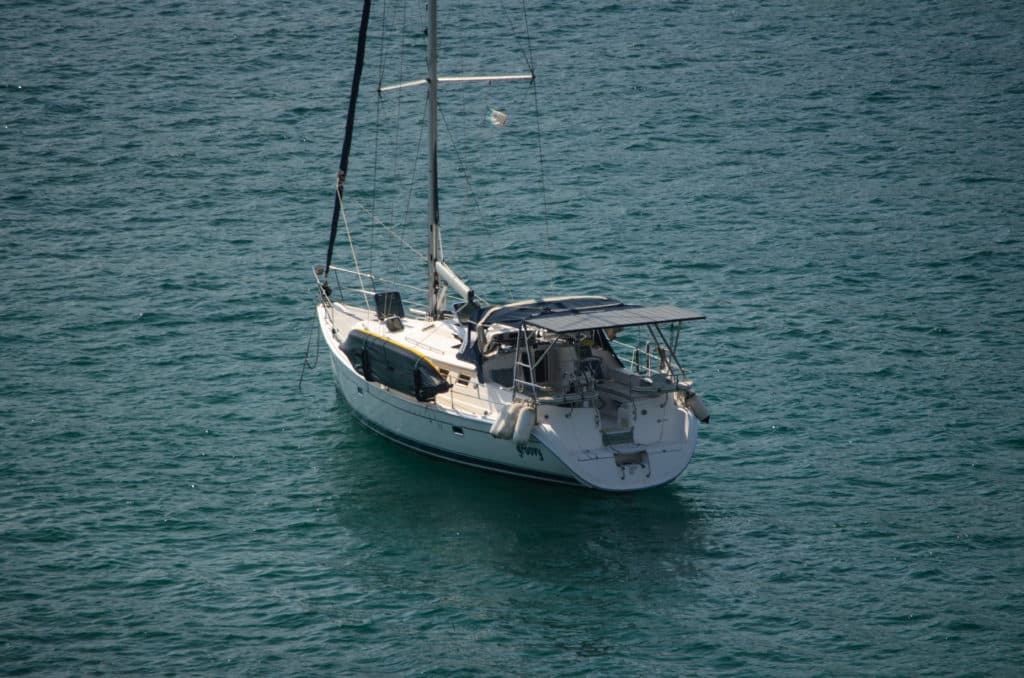
During our nearly four-year cruise of Mexico, my husband, Mark, and I lived almost exclusively on 555 watts of solar power charging a 640-amp-hour house battery bank. We anchored out virtually every night aboard our 2008 Hunter 44DS, Groovy , and relied on the sun for power. During one 10-week stretch, while we waited for a replacement engine alternator to arrive, our boat’s solar panels were our sole source of power. We had no backup charging system to turn to, and yet we lived and sailed comfortably the entire time. Mounting solar panels on a sailboat was not difficult, but a few key decisions made a huge difference in how effective our panels were.
A solar-power installation on a sailboat is made up of two independent systems: one system to charge the batteries, and another system to provide 120-volt AC power for household appliances. In the charging system, the solar panels convert sunlight into electrical current and deliver it to the batteries via a solar charge controller. Similar to a voltage regulator, the charge controller acts as a gatekeeper to protect the batteries from receiving more current than they need as they are being charged. In the AC power system, an inverter or inverter/charger converts the 12-volt DC power in the battery into 120 volts AC whenever it is turned on.
Panel Positioning and Wiring Considerations
One of the biggest challenges for sailors installing solar power on a sailboat is finding a place on the boat where the panels will be shaded as little as possible. Just a few square inches of shade on one panel can render that panel all but inoperable. Unfortunately, between the mast, radome, spreaders and boom, shadows cross the deck all day long, especially as the boat swings back and forth at anchor.
What’s worse, if the panels are wired in series rather than in parallel, this little bit of shade can shut down the entire solar-panel array. When we installed solar power on Groovy , we had already lived exclusively on solar power in an RV for over two years. Our RV solar panels had been wired in series, and we had witnessed the array shutting down current production when just half of one panel was shaded.
Choosing whether to wire the panels in series or parallel on a boat affects the wire gauge required, which is why many solar-power installers lean toward wiring the panels in series. Panels wired in series can be wired all the way to the solar charge controller with a thinner-gauge wire than those wired in parallel. This is because the voltage of panels wired in series is additive, while the current remains constant, so the current flowing is just that of a single panel. In contrast, the current flowing from panels that are wired in parallel is additive, while the voltage across them is not. This means that in a parallel installation, the current going to the charge controller is several times higher and requires much thicker cable to avoid any voltage loss over the length of the wire.
Not only is thinner-gauge wire less expensive, but it is also more supple and easier to work with, making the job of snaking it in and around various crevices in the boat and connecting it to the solar charge controller much less of a struggle. Thus the choice between series and parallel wiring boils down to a trade-off between system performance, expense and ease of solar system installation.
Luckily, the size of the wire can be reduced if higher-voltage solar panels are chosen. Since watts are determined by multiplying volts by amps, a higher-voltage panel that generates the same watts as a lower-voltage panel will produce less current. Therefore, selecting nominal 24-volt panels instead of 12-volt panels allows for the use of thinner wire sizes no matter how they are wired.
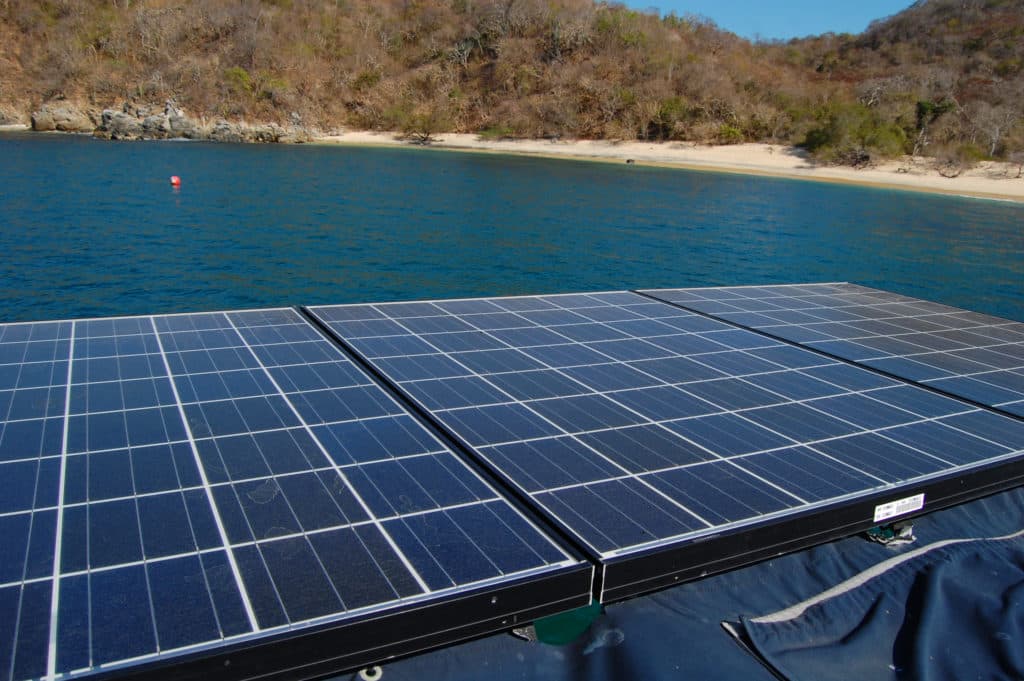
Our Marine Solar Panel Design Choices
In our installation, we decided to mount three 185-watt, 24-volt (nominal) Kyocera solar panels high above the cockpit, well aft of the boom, as far away as possible from potential shade. Our Hunter came with a big, solid stainless-steel arch, and we turned to Alejandro Ulloa, a brilliant metal fabricator at Baja Naval Boatyard in Ensenada, Mexico, to build a polished stainless-steel solar-panel arch extension onto the existing structure. He designed the arch extension with integrated telescoping davits to hoist our dinghy as well as support the solar panels. These davits were strong enough — and the lines and blocks had enough purchase — that either of us could lift our light Porta-Bote dinghy with its 6-horsepower outboard without a winch.
We spaced the panels about a half-inch apart and wired them in parallel. Using two twin-lead wires, we snaked the three positive leads and one common ground down through the inside of the arch tubes so they wouldn’t be visible, and placed wire loom over the exposed wires under the panels.
The junction points for the three parallel panels were on positive and negative bus bars inside a combiner box, all mounted in a cockpit lazarette. Inside the combiner box, we installed three breakers, one for each panel. This gave us the ability to shut off any or all of the panels if we needed to (we never did).
We mounted a Xantrex solar charge controller (model XW MPPT 60-150) in a hanging locker, as close to the batteries as possible, in a spot where it was easy to monitor and program. We ran twin-lead wire from the combiner box to the charge controller and from there to the batteries.
Our boat came with three new 12-volt Mastervolt 4D AGM house batteries, all wired in parallel, for a total of 480 amp-hours of capacity. We wanted a bigger house battery bank, and because it is best for the age, type and size of the batteries to be matched, we added a fourth new Mastervolt 4D AGM house battery, which brought our total to 640 amp-hours. Our batteries were installed at the lowest point in the hull, below the floorboards, and they ran the length of the saloon, from just forward of the companionway stairs to just aft of the V-berth stateroom door.
The best way to charge a bank of batteries that are wired in parallel is to span the entire battery bank with the leads coming from the charge controller. We did this by connecting the positive lead from the charge controller to the positive terminal of the first battery in the bank, and the negative lead from the charge controller to the negative terminal of the last battery. By spanning the entire bank, the batteries were charged equally rather than having the charging current focused on just the first battery in the bank.
We feel that AGM batteries are superior to wet cell (flooded) batteries because they can be installed in any orientation, don’t require maintenance, can’t spill (even in a capsize), and charge more quickly. Our Mastervolt batteries, like almost all AGM batteries on the market, are dual-purpose, combining the very different characteristics of both deep-cycle and start batteries. Our batteries work well, but if we were doing an installation from scratch today, we would consider the new Trojan Reliant AGM batteries. These batteries are engineered strictly for deep-cycle use and have been optimized to provide consistent current and maximize battery life.
Our boat came with a Xantrex Freedom 2,500-watt inverter/charger wired into the boat’s AC wiring system with a transfer switch. The inverter/charger performed two functions. While the boat was disconnected from shore power, it converted the batteries’ 12-volt DC power into 120-volt AC power, allowing us to operate 120-volt appliances, like our microwave. When the boat was connected to shore power, it charged the batteries.
Because this inverter/charger was a modified-sine-wave inverter, mimicking AC current with a stair-stepped square wave, we also had a 600-watt pure-sine-wave inverter to power our potentially more sensitive electronic devices. We chose Exeltech because its inverters produce an electrical signal that is clean enough to power medical equipment, and they are NASA’s choice for both the Russian and American sides of the International Space Station. For simplicity, rather than wiring the inverter into the cabin’s AC wiring, we plugged ordinary household power strips into the AC outlets on the inverter and plugged our appliances into the power strips. Like the charge controller, the inverter must be located as close to the batteries as possible. Ours was under a settee.
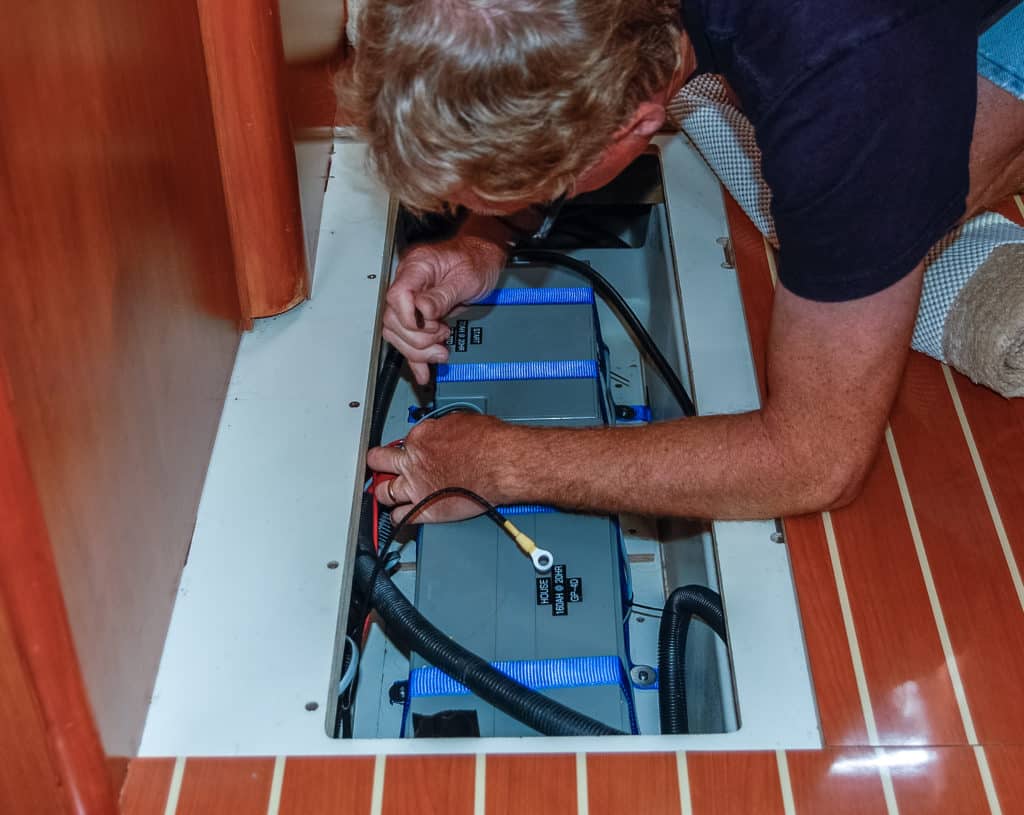
Shade’s Impact on Sailboat Solar Panels
Once our solar installation was completed on our sailboat, we closely observed the effects of shade on our solar-panel array. We were often anchored in an orientation that put the panels in full sun. Just as often, however, we were angled in such a way that shade from the mast and boom covered portions of our panels. It was fascinating to monitor the solar charge controller’s LCD display whenever the sun was forward of the beam — the current from the panels to the batteries fluctuated up and down as we swung at anchor.
Taking notes one morning, we noticed that the charging current was repeatedly creeping up and down between 9.5 and 24.5 amps as the boat moved to and fro. When the entire solar-panel array was in full sun, it generated 24.5 amps of current. When we moved so the mast shaded a portion of one panel, the array generated 15 amps. When it shaded portions of two panels and only one was in full sun, the array produced just 9.5 amps. Of course, it would have been preferable to see a steady 24.5 amps all morning, but this sure beat watching the current drop to zero whenever a shadow crossed a panel.
We discovered that shade makes a huge impact while sailing, too. Surprisingly, it is far worse to have the panels shaded by the sails than to have the panels in full sun but tilted away from its direct rays. One afternoon, we noticed that while we were on a tack that tilted the panels away from the sun, they generated 24.5 amps of current, whereas on a tack where the panels were tilted toward the sun but two of the three were partially shaded by the sails, the current dropped to a mere 10 amps.
Reflections On Our Solar Panel Installation
A wonderful and surprising side benefit of our large solar panels and arch system was that the setup created fabulous shade over the jumpseats at the stern end of the cockpit. Our metal fabricator, Alejandro, placed a support strut at hand-holding height, and sitting in those seats feels secure and comfortable while sailing, no matter the conditions.
After living on solar power for eight years of cruising and land-yacht travel, we’ve learned that you can never have too much solar power. Groovy’s 555 watts was enough to run all our household appliances as needed, including our nearly 4-cubic-foot DC refrigerator, two laptops, a TV/DVD player, and lights at night. However, it was not quite enough power to run all that plus our stand-alone 2.5-cubic-foot DC freezer during the short days and low sun angles of the winter months without supplemental charging from the engine alternator every few days. For the 10 weeks that we did not have a functioning alternator, our solution was to turn off the freezer, which enabled our batteries to reach full charge every afternoon.
Solar power made a world of difference in our cruise. Not only did it allow us to live comfortably and with ample electricity for weeks on end when our engine alternator went on the blink, but as a “set-it-and-forget-it” system, it also gave us the freedom to anchor out for as long as we wished without worrying about the batteries. In our eyes, the solar-panel arch enhanced the beauty and lines of our boat, giving her a sleek and clean appearance. It was true icing on the cake to discover that the panels and arch system also provided much-needed shade over the cockpit and helm from the hot tropical sunshine. If you are preparing for a cruise, consider turning to the sun for electricity and outfitting your sailboat with solar power.
The Installation:
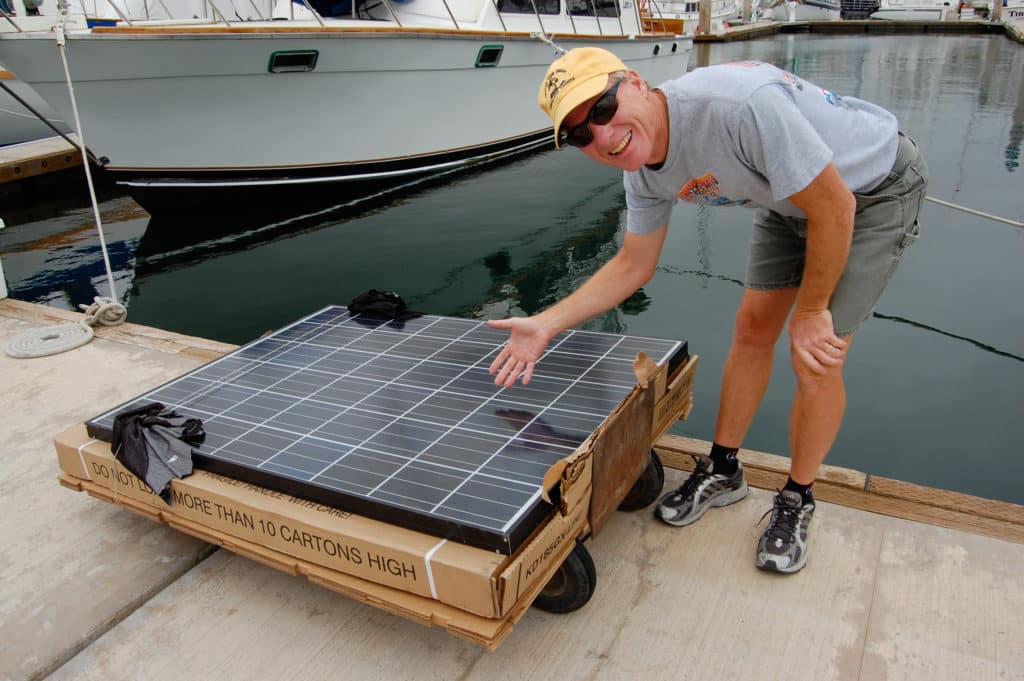
Emily and Mark Fagan offer cruising tips and share their stories and photos on their website, roadslesstraveled.us . They are currently enjoying a land cruise across America aboard an RV.
- More: DIY Sailboat Projects , green sailing , How To , installations , Refits , Sail Green , solar , solar panel , Upgrades
- More How To

Top Tools for Sailboat Cruising: Must-Have Gear for 2024

Made for Shade: Cockpit Cover Options

Blackwater Wisdom for Holding Tanks

5 DIY Basics For Your Diesel Engine
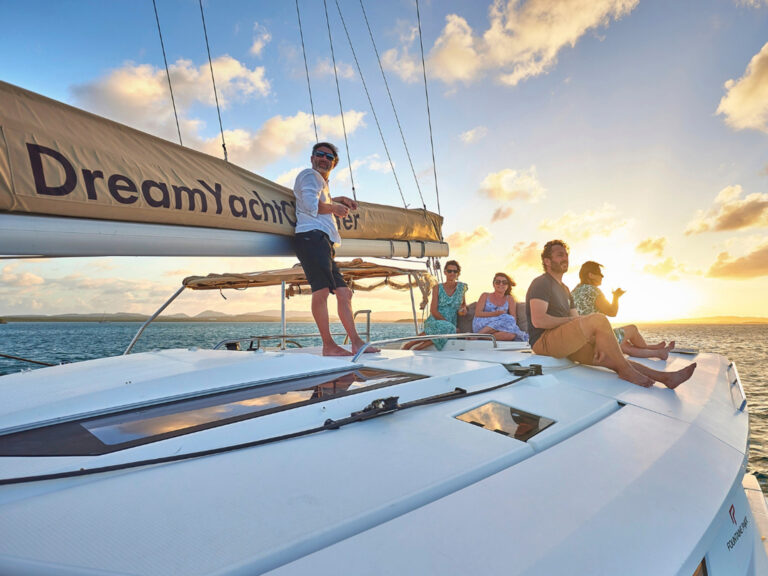
Options To Explore

For Sale: Little Harbor 63 Ketch

Cruising Tahiti: A Party in Paradise
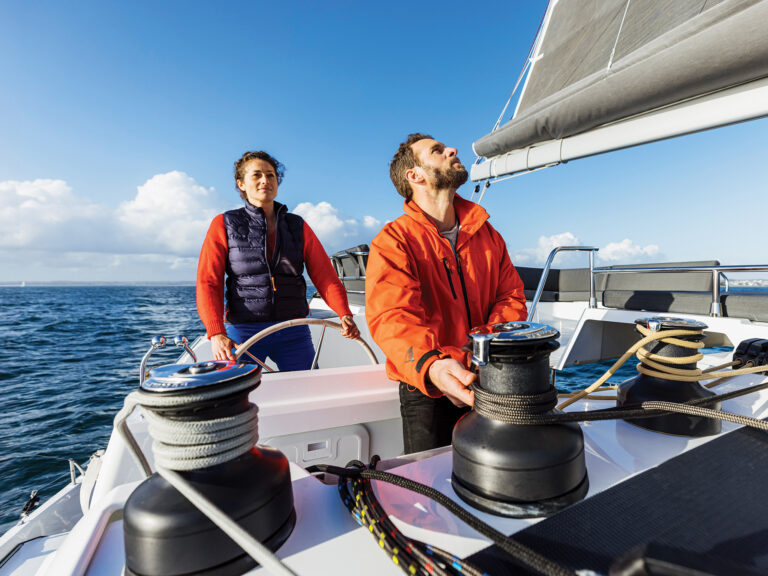
Sailboat Review: Fountaine Pajot Aura 51
- Digital Edition
- Customer Service
- Privacy Policy
- Terms of Use
- Email Newsletters
- Cruising World
- Sailing World
- Salt Water Sportsman
- Sport Fishing
- Wakeboarding

Service Locator
- Angler Endorsement
- Boat Towing Coverage
- Mechanical Breakdown
- Insurance Requirements in Mexico
- Agreed Hull Value
- Actual Cash Value
- Liability Only
- Insurance Payment Options
- Claims Information
- Towing Service Agreement
- Membership Plans
- Boat Show Tickets
- BoatUS Boats For Sale
- Membership Payment Options
- Consumer Affairs
- Boat Documentation Requirements
- Installation Instructions
- Shipping & Handling Information
- Contact Boat Lettering
- End User Agreement
- Frequently Asked Questions
- Vessel Documentation
- BoatUS Foundation
- Government Affairs
- Powercruisers
- Buying & Selling Advice
- Maintenance
- Tow Vehicles
- Make & Create
- Makeovers & Refitting
- Accessories
- Electronics
- Skills, Tips, Tools
- Spring Preparation
- Winterization
- Boaters’ Rights
- Environment & Clean Water
- Boat Safety
- Navigational Hazards
- Personal Safety
- Batteries & Onboard Power
- Motors, Engines, Propulsion
- Books & Movies
- Cockpit Confessions
- Communication & Etiquette
- Contests & Sweepstakes
- Colleges & Tech Schools
- Food, Drink, Entertainment
- New To Boating
- Travel & Destinations
- Watersports
- Anchors & Anchoring
- Boat Handling
- ← Technology
What You Need To Know About Boat Solar Panels
Advertisement
Sunshine and boats are a natural together, so why not use all that free energy? Here’s the lowdown on solar panel selection and installation
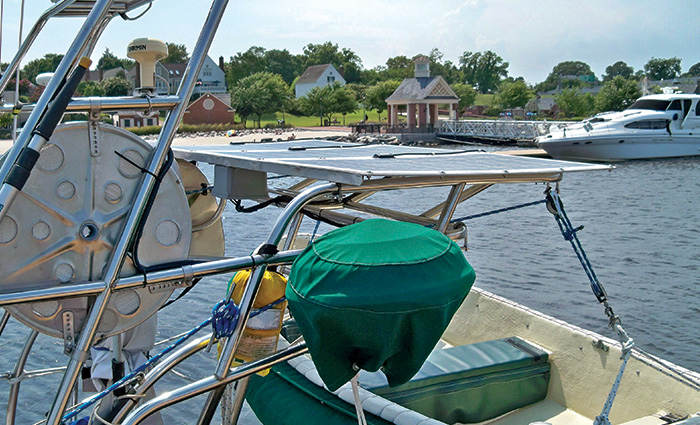
I first embraced the idea of solar power while up a pole (literally) in the Atlantic Intracoastal Waterway replacing dead batteries. It was the early 1980s, and I was maintaining buoys, beacons, and other such Aids To Navigation (ATON) for the U.S. Coast Guard, replacing massive, nonrechargeable batteries with rechargeable solar-powered ones. The higher-ups said the solar rechargeables would last six years – twice as long as the one-shot batteries. As the deck-ape in charge of lugging all those batteries up and down the ladders, my back and I immediately appreciated the whole “free power from the sun” thing, a concept I continue to embrace.
The strategy behind s olar energy onboard is simple: A solar panel converts sunlight into electricity, after which wiring conducts it to your batteries for storage until needed. Solar panels are used to keep batteries or banks charged rather than to power equipment directly. This arrangement allows the panels to store generated power whenever produced, while providing a steady source of power to a piece of equipment even when the panel is producing no power.
While they do require an initial outlay, solar panels can easily pay for themselves in money saved and independence gained over their service life. They’re noiseless, have no moving parts, and they provide free electricity for years with minimal maintenance. Solar panels also have the benefit of being modular, letting you start small and add more as your power requirements increase.
The benefits of solar
Almost any boat can benefit from solar power. Whether at a slip, mooring, or on a trailer, boats can keep their batteries topped off without the need for external power. You can also use solar power to supplement or even replace other onboard charging sources, reducing or eliminating the need to run engines or generators to keep batteries topped off (a wasteful practice that burns fuel while wearing down the costliest pieces of equipment onboard).
While underway, it’s a plus to be able to recharge a dead battery in an emergency – say, to operate a VHF radio or navigation gear. While dockside, solar panels keep batteries charged and vital systems (such as bilge pumps) up and running without the need for shore power.
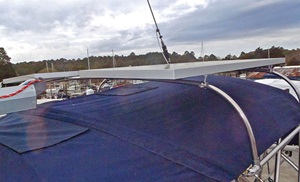
Just about any boat can benefit from solar power, whether it’s to keep batteries topped off or supplement other onboard charging sources.
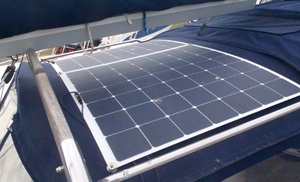
Mount solar panels where they are exposed to maximum sunlight but do not interfere with operation of the vessel.
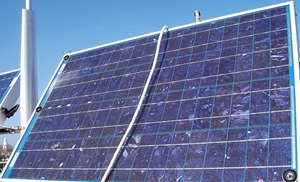
Bottom: Something as simple as the shadow of a line or shroud can reduce or halt output.
Types of panels
Solar panels contain photovoltaic cells – small silicon semiconductor devices that convert sunlight into electricity. Each cell generates between 0.45 and 0.5 volts, depending on exposure to direct sunlight. Cell size determines amperage, with a 3-inch cell producing roughly 2 amps, a 4-inch cell a little over 3 amps, and a 5-inch cell around 5 amps.
Construction-wise, the three main types of solar panels are monocrystalline, polycrystalline, and amorphous (or thin-film) technology.
Monocrystalline panels have been around the longest and remain the most popular. The panels are constructed of thin slices of crystal silicon (each cell is cut from a single crystal) housed in a rigid, aluminum frame and covered with tempered shatterproof glass. The panels have a uniform black, blue, or gray appearance and are generally quite rugged, although they can be cracked or broken if subjected to extreme abuse.
Monocrystalline panels have the longest service life of the three types. With a conversion efficiency of around 17%, they’re also the most efficient and have the highest electrical output per area, but they are also the most expensive.
Polycrystalline cells are sliced from a cast silicon block and have a shattered glass appearance. Built in much the same way as monocrystalline panels, they’re rectangular, giving the panel itself a tiled look. Their life span is similar to monocrystalline panels, and while their conversion efficiency is lower (by 14%), they’re also a bit less expensive.
Amorphous panels are made by placing a thin film of active silicon on a solid or flexible backing (such as stainless or aluminum sheeting) depending on whether the panel is to be rigid-framed and glass-fronted or flexible. Flexible amorphous panels, in which cells are sandwiched between rubber and polymer covers, are light and tough enough that you can walk on them and, in some cases, even roll them up for storage.
This type of solar panel is also better if shade is an issue. With crystalline panels, even the thin shadow of a rope or shroud across one cell can reduce or halt output of an entire module. Amorphous panels have “bypass” diodes that essentially turn off shaded cells and provide a current path around them. Some monocrystalline panels also have bypass diodes, but this feature comes at an increase in cost.
Amorphous panels are the least expensive of the three types, but their efficiency is also lower – around 8%, or roughly half that of a monocrystalline type. This lower output is somewhat mitigated in newer panels, however, which use three-layer construction. Each layer absorbs different colors of the solar spectrum, so the panel will deliver more power longer each day and during lower light conditions than the other two types.
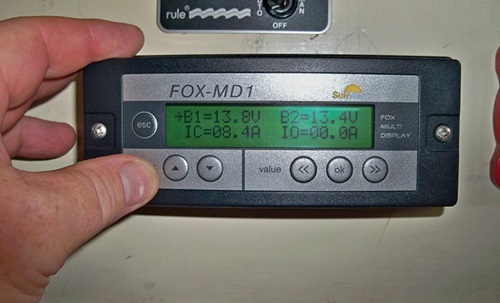
The charge controller should be mounted below decks and as close to the battery as possible.
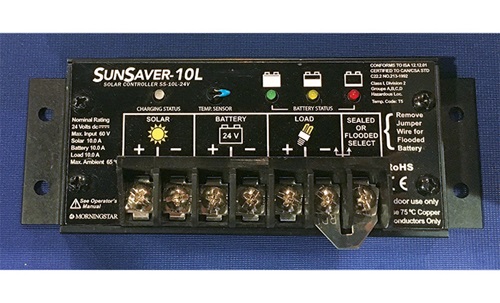
Follow manufacturer instructions for wire connections.
Planning the system
While factors such as cost, mounting options, and output are important, a successful installation depends on knowing what you want the system to accomplish. Is the goal to float-charge a single battery or supplement an overall vessel energy plan? Answering these questions up front will help determine the type, size, and number of panels required.
To understand the process better, let’s walk through the basic steps to determine power requirements and installation considerations for a single solar panel installation. While the example itself is simple, the steps are the same used to plan more complicated installations.
For our example, the goal is to install a solar panel to provide charging for a single 12-volt, 100-amp-hour wet-cell battery used to power an automatic anchor light on a moored vessel.
The first step is compiling a daily power consumption estimate to determine how much solar power is needed.
The daily self-discharge rate for a wet-cell battery is roughly 1%, meaning our 100-amp-hour battery requires one amp every 24 hours just to maintain the status quo. The anchor light draws 50 milliamps per hour of operation, and we’ll assume it operates 10 hours each night. Multiplying current draw (50 milliamps) by hours of daily operation (10) generates a daily energy expense of 500 milliamps or .5 amps.
This means our solar panel must meet a minimum daily energy tab of 1.5 amps – one amp of battery self-discharge rate plus .5 amps of power draw for the anchor light.
Next up is figuring out panel size and the best mounting location. For our example, let’s assume the panel will be a horizontal, fixed-mount installation. A 10-watt horizontally mounted panel should generate between 3- and 5-amp hours per day.
We’ll need at least 13 volts to fully charge our 12-volt battery. As most solar cells generate at least 0.45 volts, you’ll want a panel with a minimum of 33 cells, which should provide around 14.85 volts.
Keep in mind that’s the minimum needed, which may not be enough once you factor in a few cloudy days. Most panels are designed to generate between 15 and 20 volts to overcome problems like cloudy days or inherent electrical resistance within the panel or installation components. While this higher voltage lets you make up for less electrically productive days, it also means you’ll want to install a solar charge controller (voltage regulator) to avoid battery damage due to overcharging.
Attempts to plan a system that tries to use the output of the panel and capacity of the battery to prevent overcharging (and avoid the installation of a charge controller) is false economy and should not be done. The system will never meet its full output potential and, worst case, can damage the battery due to overcharging.
A word on ‘charge controller confliction’
If your vessel has multiple charging sources, such as solar panels and a wind turbine, a crucial but often overlooked consideration is “charge controller confliction.” In short, this is an issue where the charge controller for your solar panel and the charge controller for your wind turbine are internally adjusted to the same maximum charge voltage set point. This means they are constantly fighting each other to be the dominant power source, which results in diminished overall charging output and performance. An in-depth article on this issue can be found at missioncriticalenergy.com (in the website footer, click “Superwind Turbine Manuals & Technical Bulletins.” Under the header “Charge Controllers,” select the document “Resolving Charge Controller Confliction”).
While this article addresses charge controller confliction at remote, off-grid sites, the information provided is also applicable to vessel installations. — F.L.
Location and mounting
Solar panels should be mounted in a location where they are exposed to the maximum amount of sunlight but do not interfere with operation of the vessel or the movement of passengers and crew. Solar panels will typically be either fixed or mounted on some type of movable bracket that allows you to actively point the panel toward the sun for maximum output. Both methods have their pros and cons. Fixed panels (which are normally mounted horizontally) don’t produce as much power as a panel that can be adjusted to face the sun. The downside is that adjustable panels must be aimed throughout the day to maximize their output.
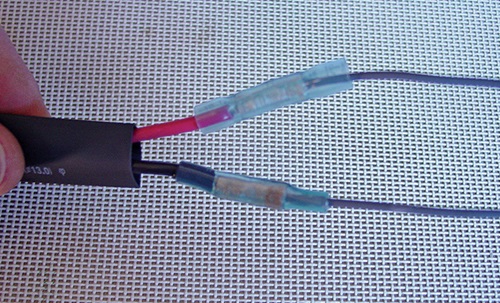
Use good quality, marine-grade heat shrink connectors (top) and liquid electrical tape (right) to create airtight, waterproof seals and reduce corrosion.
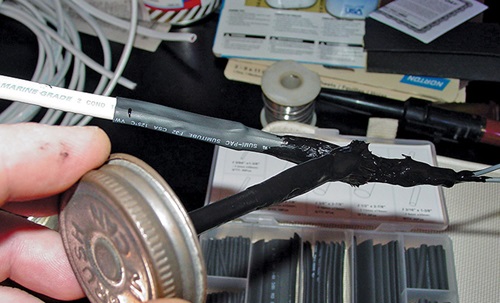
Installation
After choosing and mounting your panel, it’s time to connect it. The first thing you need to determine is the size (gauge) of the wiring to be used. Multiply your panel’s rated amp output by 1.25 (which adds a 25% safety factor). Then measure the length of the entire wiring run, panel to battery, and multiply by 2. Once you have these two numbers, refer to the American Boat and Yacht Council’s (ABYC) 3% voltage-drop table for wire size. Ancor Products offers a handy wire calculator on its website ( ancorproducts.com/resources ).
Always use good quality marine grade connectors and tinned, multi-stranded copper wire with vinyl sheathing. The wire will run from the solar panel to the charge controller first, then to the battery. Try to keep the wire run as short as possible, and if it transits an external deck or cabin house (it likely will), be sure to use an appropriate weatherproof deck fitting.
The charge controller should be mounted below decks and as close to the battery as possible. You’ll always want to follow the manufacturer’s instructions for connections, but in a typical installation you’ll connect the solar panel’s positive (red wire) lead to the charge controller’s positive input wire or terminal and the negative (black wire) lead to the charge controller’s negative input wire or terminal.
Next, connect the charge controller’s negative output to the battery negative terminal and the controller’s positive output to the battery’s positive terminal via an appropriately sized in-line fuse (or circuit breaker). ABYC recommends these be installed within 7 inches of connection to the battery or other point in the DC system. To reiterate, the installation of the charge controller can vary among models, so follow the manufacturer’s installation instructions.
Finally, ensure all connections are waterproof and secure any loose wire runs with wire ties and cable clamps for a neat installation. Then get ready to lean back and soak up some free sun.
Related Articles
The truth about ceramic coatings for boats.
Our editor investigates the marketing claims of consumer-grade ceramic coatings.
Fine-Tune Your Side Scan Fishfinder
Take your side-scanning fishfinder off auto mode, and you’ll be spotting your prey from afar in no time
DIY Boat Foam Decking
Closed-cell foam flooring helps make boating more comfortable. Here’s how to install it on your vessel
Click to explore related articles
Frank Lanier
Contributing Editor, BoatUS Magazine
Capt. Frank Lanier is a SAMS-accredited marine surveyor with over 40 years of experience in the marine and diving industries. He’s an author, public speaker, and multiple award-winning journalist whose articles on boat maintenance, repair, and seamanship appear regularly in numerous marine publications worldwide. Contact him via his YouTube channel “Everything Boats with Capt. Frank Lanier” or at captfklanier.com.
BoatUS Magazine Is A Benefit Of BoatUS Membership
Membership Benefits Include:
Subscription to the print version of BoatUS Magazine
4% back on purchases from West Marine stores or online at WestMarine.com
Discounts on fuel, transient slips, repairs and more at over 1,200 businesses
Deals on cruises, charters, car rentals, hotel stays and more…
All for only $25/year!
We use cookies to enhance your visit to our website and to improve your experience. By continuing to use our website, you’re agreeing to our cookie policy.

Top 3 Best Solar Panels For Sailboats

Last Updated by
Daniel Wade
June 15, 2022
Choosing whether or not to install solar panels on your sailboat is a big decision. They are not exactly cheap, though they can start to pay themselves off pretty quickly.
This article is going to cover not only why you might want to use solar panels but all the benefits they provide. You will also find a helpful guide on which solar panels would be best for you and your budget. Hopefully, by the end, you will feel confident in your decision to install solar panels on your sailboat and even have an idea of which ones you might like.
Table of contents
Are solar panels on sailboats necessary?
Whether or not you should be installing solar panels on your boat is a matter of choice, not out of necessity. Sailboats get their power from the wind, by harnassing it in their sail. So if you plan to be sailing for the afternoon you probably don’t need solar panels.
You could charge a battery pack from the marina and that will probably see you through several trips. The problems only really start to arise if you are planning to be on your sailboat for longer periods, or even permanently. If you plan to live on your sailboat year-round, even if you spend 80% of it in a marina, you would be better off with some solar panels. Even if it is just as a backup source of power.
Are solar panels on boats safe?
Solar panels are generally pretty safe. They have no moving parts and typically have a very strong protective cover over them so you never come in contact with the electrics themself. So, as a source of power, they are generally pretty safe. The only time they may become unsafe is if they are badly damaged.
Solar panels are often covered by glass plating that keeps them safe. It also helps them absorb sunlight and warmth. This is great, except when the glass breaks. If the glass protective cover on your solar panels should crack and splinter you are at risk of serious injury from sharp shards of glass. Not only is the glass itself dangerous at this point, so are the electronic components inside. They have powerful currents running through them, and if you come in contact with them you may be in for a shock.
Furthermore, if these electronics get wet they can become deadly. Electricity and water do not mix well at all. Being as you are on a sailboat, at sea, the chances of them getting wet is very high. Luckily, the chances of them breaking in the first place are slim to none. The only real way they would break, besides vandalism, is by debris hitting them during a bad storm. There is not often debris at sea, so this shouldn’t be too much of a problem.
What are the benefits of having solar panels on a sailboat?
There are so many great benefits of having solar panels on a sailboat. They can be a lifesaver if you find yourself at sea for a long time. There benefits range from trivial comforts to being the difference between life and death. Here are some of the benefits you might not have considered about having solar panels installed on your sailboat.
Money-saving
Solar panels are not cheap, it is far cheaper to just run a generator or charge your batteries from the marina the whole time. At least, it is in the short term. Over time, it can start to become very expensive. With solar panels, you are looking at a big initial cost (the solar panels themself) and then it’s smooth sailing. You don’t need to pay for power again. Solar panels last for about 40 years before they start to become too inefficient at producing power. The cost of a few solar panels upfront compared to 40 years of marina fees and gasoline for a generator is the financially savvy move.
Emergency power
If you find yourself at sea, the wind dies down (or becomes too strong), and you find yourself stuck bobbing around waiting for more favorable conditions you may run into trouble. Depending on how long you are out there, you may find yourself with dead electronics. Be it a satellite phone, radio, or secondary engine (depending on the boat). Having a set of solar panels and a power bank can be a genuine lifesaver in these situations.
Comfort amenities
Whether you are day sailing or making a week-long voyage, having access to the comforts in life can make the whole journey so much more enjoyable. The amenities may not be available to you without having a constant source of power at sea. Having access to a kettle, tv, videogame system, radio or microwave oven may be the only thing keeping you going at rougher times. As exciting as sailing can be, when you aren’t sailing and are just bobbing around it can be quite dull. The sea is beautiful, but there is only so much time you can spend looking at the water before you miss the comforts of land. With solar panels, you can bring those comforts with you.
Eco-friendly
There are only two alternatives to solar panels. A gasoline generator, and taking power from the grid. Neither of these is good for the environment. Luckily, solar panels are a great third option. Solar panels are completely eco-friendly and are great for the environment. This is not just great for the earth, and your conscience, but for the journey itself. If you are running a gasoline generator at sea you are going to be listening to it thrumming away and smell the burning gasoline. Wouldnt you prefer silence and nothing but the smell of the sea breeze?
How much do solar panels cost?
How much solar panels cost is almost entirely tied into both their voltage/wattage and whether or not they are portable panels. Portable solar panels are great for people who don’t spend a lot of time on their boat or are happy enough living off the marina’s power grid. Permanent solar panels, the kind that may need to professionally installed, can end up costing far more. They are also likely to be far superior and you can pretty much forget about them once they are installed.
Portable solar panels will cost just a few hundred dollars each. You will need a few to be sustainable, but that’s not going to be much of a problem. These portable solar panels can just be rolled out on the deck of your boat, weighed down, and then hooked up to a battery pack. The battery itself here is going to be the most expensive part of the whole set up. A decent-sized battery could set you back a $1000. But, when charged fully it will last days. Even with constant use.
Permanently installed solar panels can cost one or two thousand dollars in some cases. The advantage here though is once they are installed that’s it, you can forget about them. You don’t have to put them up, take them down, and find somewhere to stow them every time they need using. They too will need to be hooked up to a battery, the battery is still only going to cost you $1000. If you are installing permanent solar panels because you plan to be making long voyages, it is ideal to have two or perhaps even three large batteries hooked up to your boat. One to run off, one or two for emergencies.
How do I maintain my solar panels?
Solar panels, unlike gasoline generators, are generally pretty easy to maintain. They have no moving parts and are thus pretty self-sufficient. They don’t need taking apart and they last as long as 40 years. That being said, if they do break they need repairing as soon as possible. The exposed electrics can be deadly when water is thrown into the mix. Which, on a boat, is almost always. The glass cover will need replacing and the electronics inside may need repairing, though not always. Don’t ever attempt to do this yourself unless you are experienced at making these repairs. The cost of hiring someone to do it for you is preferable to being dead. Solar panels have very powerful electric currents, that when in contact with water and yourself can be fatal. As mentioned above, these panels rarely break so you will likely not ever run into this problem. If you do, hire a contractor.
Do my solar panels need cleaning?
Solar panels work by converting the light and heat of the sun into useable power. The process itself is rather complicated but the results are simple to understand. That being said, there are some reasons that your solar panels will stop working as effectively. They all revolve around a lack of sunlight. It could be because it is night time. It could be because it is very cloudy. Or, it could be because they are dirty. If solar panels become too dusty, dirty, and become too covered in grime they stop operating at maximum efficiency. This is not as much of a problem at sea, the sea spray stops dust settling. The biggest thing you will need to clean off your solar panels is salt build-up and slime. This is easy enough to do with some warm soapy water. Freshwater, not seawater. You want to be removing as much salt as possible. Salt is corrosive to electronics, so removing it is important. Never clean your solar panels using pressure washers as they can crack the glass.
Which are the best solar panels for sailing?
There are so many options on the market at various price points. Here are three very different options that will all make good choices, depending on your needs. It is important to consider not just price but power output. Spending a lot of money on solar panels now might not feel ideal, but it is the most cost-effective decision.
1. Renogy Starter Kit
This starter kit is going to be perfect for installing on almost any sized boat. There are four solar panels, each can be fitted permanently to the boat. They can be mounted (and unmounted) easily, for your convenience. They do require a flat surface, but they are small enough that that likely won’t be too much of a problem. This starter kit is very middle of the pack price-wise but should provide enough power for a small to medium-sized vessel easily. It is also possible to buy extra panels individually should you need them.
Wattage: 400/4 (100 per panel)
2. Nature Power Rigid
The nature power rigid is a large, powerful, single solar panel. If you are looking for the right panels to power your entire boat comfortably, these are the ones for you. They are very large so they will need a large flat surface area. alternatively, they can be hung vertically from rails. This is an inefficient way of using them, so you would need to buy more this way. Nature power makes various solar panels so you could find some smaller ones of the same brand to supplement it. This one is not so easy to install, you might need to hire someone to install it for you.
Wattage: 165
3. Nature Power Monocrystalline
Nature power makes a portable solar panel that fits inside a special briefcase. It is perfect for stowing away easily and only taking it out when it is needed. It is decently powerful considering its portable, but there is the inconvenience factor of having to set it up each time. If you planned to buy the nature power rigid, buying one of these portable panels might be ideal for supplementing your power supply when it is especially sunny. Though, it may be cheaper for you to just fit more of the Nature Power Rigids.
Wattage: 120
Hopefully, you now have a good idea about whether solar panels would be right for you and your sailboat. Sailing is great, but the lack of power at sea can be dreadfully boring. Luckily, there are so many great options available on the market. Not just the ones mentioned above. Buying a solar panel is an investment, the initial cost is minor compared to the steady return from all the savings you will make.
Related Articles
I've personally had thousands of questions about sailing and sailboats over the years. As I learn and experience sailing, and the community, I share the answers that work and make sense to me, here on Life of Sailing.
by this author
Sailboat Upgrades
Most Recent

What Does "Sailing By The Lee" Mean?
October 3, 2023

The Best Sailing Schools And Programs: Reviews & Ratings
September 26, 2023
Important Legal Info
Lifeofsailing.com is a participant in the Amazon Services LLC Associates Program, an affiliate advertising program designed to provide a means for sites to earn advertising fees by advertising and linking to Amazon. This site also participates in other affiliate programs and is compensated for referring traffic and business to these companies.
Similar Posts

How To Choose The Right Sailing Instructor
August 16, 2023

Cost To Sail Around The World
May 16, 2023

Small Sailboat Sizes: A Complete Guide
October 30, 2022
Popular Posts

Best Liveaboard Catamaran Sailboats
December 28, 2023

Can a Novice Sail Around the World?
Elizabeth O'Malley

4 Best Electric Outboard Motors

How Long Did It Take The Vikings To Sail To England?

10 Best Sailboat Brands (And Why)
December 20, 2023

7 Best Places To Liveaboard A Sailboat
Get the best sailing content.
Top Rated Posts
Lifeofsailing.com is a participant in the Amazon Services LLC Associates Program, an affiliate advertising program designed to provide a means for sites to earn advertising fees by advertising and linking to Amazon. This site also participates in other affiliate programs and is compensated for referring traffic and business to these companies. (866) 342-SAIL
© 2024 Life of Sailing Email: [email protected] Address: 11816 Inwood Rd #3024 Dallas, TX 75244 Disclaimer Privacy Policy
- New Sailboats
- Sailboats 21-30ft
- Sailboats 31-35ft
- Sailboats 36-40ft
- Sailboats Over 40ft
- Sailboats Under 21feet
- used_sailboats
- Apps and Computer Programs
- Communications
- Fishfinders
- Handheld Electronics
- Plotters MFDS Rradar
- Wind, Speed & Depth Instruments
- Anchoring Mooring
- Running Rigging
- Sails Canvas
- Standing Rigging
- Diesel Engines
- Off Grid Energy
- Cleaning Waxing
- DIY Projects
- Repair, Tools & Materials
- Spare Parts
- Tools & Gadgets
- Cabin Comfort
- Ventilation
- Footwear Apparel
- Foul Weather Gear
- Mailport & PS Advisor
- Inside Practical Sailor Blog
- Activate My Web Access
- Reset Password
- Customer Service

- Free Newsletter

Mason 33 Used Boat Review

Beneteau 311, Catalina 310 and Hunter 326 Used Boat Comparison

Maine Cat 41 Used Boat Review

Cheoy Lee Clipper 36 & 42 Used Boat Review

Tips From A First “Sail” on the ICW

Tillerpilot Tips and Safety Cautions

Best Crimpers and Strippers for Fixing Marine Electrical Connectors

Thinking Through a Solar Power Installation

Stopping Mainsheet Twist

Working with High-Tech Ropes
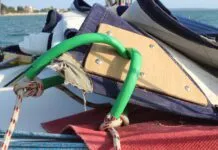
Getting a Clue for the Blown-Out Clew
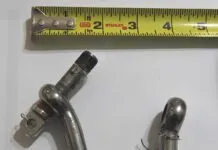
Monel Seizing Wire is Worth the Extra Cost

Fuel Lift Pump: Easy DIY Diesel Fuel System Diagnostic and Repair

Ensuring Safe Shorepower

Sinking? Check Your Stuffing Box

The Rain Catcher’s Guide

Boat Maintenance for the Technically Illiterate: Part 1

Whats the Best Way to Restore Clear Plastic Windows?

Mastering Precision Drilling: How to Use Drill Guides

Giving Bugs the Big Goodbye

Galley Gadgets for the Cruising Sailor

Those Extras you Don’t Need But Love to Have

UV Clothing: Is It Worth the Hype?

Preparing Yourself for Solo Sailing

How to Select Crew for a Passage or Delivery

Preparing A Boat to Sail Solo

On Watch: This 60-Year-Old Hinckley Pilot 35 is Also a Working…

On Watch: America’s Cup

On Watch: All Eyes on Europe Sail Racing

Dear Readers

Chafe Protection for Dock Lines
- Belowdecks & Amenities
- Marine Electronics
- Subscriber Only
- Systems & Propulsion
What are the practical considerations for the design and installation of a solar power system on your sailboat?

The practical aspects of your solar panel system will be governed by the design and size of your sailboat, your overall project budget (% DIY project) and how you currently use your sailboat versus your future plans for your boat. The intent of this article is not to design or size your solar system, but to offer some real-world practical guides and considerations. You may have other sources of power from an auxiliary engine alternator or a separate diesel generator, but ideally you will want to optimize your solar power system generation when possible.

Subscribe to Practical Sailor
Already subscribed, related articles more from author.
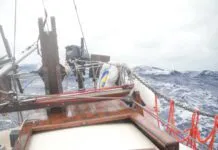
Responding to Emergencies: A Skipper’s Guide for Staying Calm
Leave a reply cancel reply.
Log in to leave a comment
Latest Videos

The Perfect Family Sailboat! Hunter 27-2 – Boat Review

Pettit EZ-Poxy – How to Paint a Boat

The Boat From True Spirit – Sparkman & Stephens

Top 5 Boat Hacks – Boat Maintenance Tips and Tricks
Latest sailboat review.

- Privacy Policy
- Do Not Sell My Personal Information
- Online Account Activation
- Privacy Manager
Yachting Monthly
- Digital edition

Best Solar panels for off-grid power and keeping batteries charged
- Phil Sampson
- November 28, 2022
We take a look at 6 of the best solar panels for boats, from folding units to cutting-edge flexible panels

Free power forever? If only it was that simple! Photo: Graham Snook
For many in the boating community, solar panels represent something of a holy grail. They are, after all, the gift that keeps on giving, aren’t they? Free power forever, (or many years anyway), coupled with zero running costs – what could possibly be better than that?
All you have to do to make this dream come true is banish the memory of the purchase price from your mind – something boaters are notoriously adept at doing – and wait for the sun to shine. If only it were that simple…
The fact of the matter is that there are costs associated with solar panels beyond the price of the panels themselves. While some types of panels can be simply laid on the deck, in many cases some form of mount will be required.
Then there’s the wiring to hook them up to your battery, plus any fitment and/or cosmetic work needed to hide the cabling from view. If your panels are to be left connected permanently, you’ll require a regulator too.
This will prevent both overcharging and a reverse flow of power out of the battery after dark. If you do not fit a regulator, a blocking diode can be used to halt the reverse flow instead.
But once all of the above have been overcome – and providing you’ve done your homework to ensure your panels will generate sufficient power to cover your needs – then, yes, it’s a power free for all!
There are many other benefits to boat solar panels too: First and foremost, they work all on their own – solar panels are automatic, so you can just let them get on with the job.
Apart from the occasional wipe over and a wiring check, they’re largely maintenance-free too. Unlike wind generators, (especially like the one with wonky bearings on that boat moored next to you), they don’t make any noise.
And finally, your batteries will be pleased, because keeping them from going flat can extend their life.
Here’s our choice of the best boat solar panels.
6 of the best boat solar panels available right now

Giosolar 1,000W flexible solar panel
Best flexible boat solar panel
Delivering a mighty kilowatt of power, (not far off the amount used by a one bedroom house), this Giostar package comprises ten separate 100W panels, each of which is 1,050 x 540 x 2.5mm in size.
Capable of charging either 12 or 24V batteries, a kit of this magnitude is one for the most serious of solar enthusiasts – Eco Experts reckons 660-990W is sufficient for a liveaboard.
Giostar panels are abrasion resistant, anti-rust and dust proof and their junction boxes are sealed and waterproof. The panels are also light, thin and flexible, and can withstand being bent up to 30 degrees.
Reasons to buy: Incredible amount of power, panels are abrasion resistant as well as anti rust + dust proof
Reasons to avoid: Premium price
Price: £1,464.45
Buy it now on Amazon (UK)
Note: We may earn a commission when you buy through links on our site, at no extra cost to you. This doesn’t affect our editorial independence.
Ecoflow 160w portable solar panel.

Mobisolar 100W foldable solar panel
Best foldable boat solar panel
Mobisolar’s foldable panels are light (4.5kg) and measure 121 x 56.5 x 3 cm when unfolded, with the longest dimension reducing to 60 cm when folded, making them easy to transport.
The panels use advanced technology to provide superior performance, with each panel subjected to a thorough testing routine before and after assembly.
So confident is Mobisolar in its products that the company stands behind its panels with a two-year defect warranty and a five years’ electrical performance warranty.
For maximum flexibility in operation, three USB power outputs are fitted per panel, one delivering 100W, the second 60W and the third 10W.
Reasons to buy: Foldable, lightweight and long warranty
Reasons to avoid: Not resistant to the elements, doesn’t feature mounting holes
Price: £145.00
Buy it now on eBay

Eco-worthy 100W solar panel kit
With 100W panels being ideal for keeping batteries topped up, our second offering in this power class is from Eco-worthy, a major player in the solar panel field.
Competitively priced, our link below is for a kit which includes an LCD control unit and four ‘Z’ brackets in addition to the panel itself.
The Eco-worthy 100W panel is of the monocrystalline type, which means their cells are made from an ingot grown from a single silicon crystal of high purity. It’s also a rigid panel, so this particular product would need to be mounted on a frame or flat surface.
Reasons to buy: Competitively priced, Features LCD panel, brackets
Reasons to avoid: Only a year warranty, not resistant to elements
Price: £113.99

PV Logic 20W Flexi solar panel
Offered by Force 4 Chandlery, this lightweight semi-flexible solar panel comes complete with a dual battery solar charge controller.
The panel is completely waterproof thanks to its six-layer, heavy-duty laminate finish, and should a wayward crew member plod over it in their size 9s the panel’s dimpled top surface is ‘self healing’.
The controller can handle both 12 and 24V systems and the panel’s PWM (Pulse Width Modulation) charging system is efficient and battery-lifetime friendly.
Supplied with LED battery-status indicators and 4 metres of cable, PV Logic Flexi panels can be bonded to flat or curved surfaces.
Reasons to buy: Lightweight, waterproof, dual controller
Reasons to avoid: Lacks mounting options
Price: £149.95
Buy it now on Force 4 Chandlery

Powoxi 10W solar panel
At the budget end of the market comes this Powoxi 10W solar panel charger kit. While you won’t go far on just 10W of power, this kit claims to be capable of charging and maintaining various 12V batteries.
The kit features a fully automatic charging and maintenance controller, which provides intelligent three-level charging and protection against short- and open-circuits, under voltage and overloading.
A reverse flow system is included and the interface is described as ‘plug and play’. While the panel is rainproof, it will not withstand immersion in water, so this is a product to perhaps leave behind on the dock when you take to the water.
Reasons to buy: Great budget option, plug and play
Reasons to avoid: Not waterproof, won’t go far on 10V
Price: £27.59

Eco-worthy 10W/5W solar panel
The least pricey option we could find anywhere, this baby 5W solar panel is simply a trickle charger. But if that’s all you need then look no further, for this is another Eco-worthy product.
The technology in the panel is polycrystalline, so it’s not the most efficient on the market, but for this power that’s hardly a great concern.
The panel is supplied with two charging options; a pair of crocodile clips which attach directly to the battery, and a cigarette lighter plug.
According to the product’s eBay listing, this seller alone has sold approaching 3,000 of these units – and at this price, we can understand why!
Reasons to buy: Incredible price, can be charged via car lighter plug
Reasons to avoid: Small, not very efficient
Price: £9.99
Questions? Call Us Today:
Monday - Thursday: 10am - 5:30pm EST Friday: 10am - 1pm EST
- Get Free Proposal
- Lite Power Kits
- Remote Power Kits
- Backup Power Kits
- Off-Grid Power Kits
- Hybrid Power Kits
- Microinverter Kits
- All Solar Kits
- EcoFlow River 2
- EcoFlow River 2 Pro
- EcoFlow Delta 1800 [Hot]
- EcoFlow Delta 2
- EcoFlow Delta MAX
- EcoFlow Delta MAX 2
- EcoFlow Delta PRO [Best Seller]
- EcoFlow Delta PRO ULTRA
- EcoFlow Delta Pro 3 [New Release]
- C800X [New Release]
- F3800 [New Release]
- Bluetti AC2P
- Bluetti AC240P
- Bluetti AC60P
- Bluetti AC70P
- Bluetti AC180P
- Bluetti AC200 MAX [Best Seller]
- Bluetti AC200P L
- Bluetti AC300
- Bluetti AC500 [Hot]
- Bluetti EP500
- Bluetti EP800
- Bluetti EP900
- Jackery 240
- Jackery 500
- Jackery 1000
- Jackery 1500
- Jackery 2000 PLUS
- Jackery 4000
- FORCE 15K ESS [New Release]
- Hysolis MPS 3K
- Hysolis Apollo 5K [New Release]
- Hysolis Dual Apollo 5K
- Power E [Best Seller]
- Power Union
- Titan Boost [New Release]
- Titan 240SP
- SuperBase V [Best Seller]
- SuperBase V EXP
- All Solar Generator Kits
- All Solar Panels
- Solar Panels by Pallet
- Used Solar Panels
- Monocrystalline Solar Panels
- Polycrystalline Solar Panels
- Portable Solar Panels
- Flexible Solar Panels
- Bifacial Solar Panels
- 100 Watt Solar Panels
- 200 Watt Solar Panels
- 300 Watt Solar Panels
- 400 Watt Solar Panels
- 500 Watt Solar Panels
- Cabling & Wire
- Battery Chargers
- Bus Bars, Fuses, and Connectors
- Bluetti Accessories
- EcoFlow Accessories
- EMP Shields & Faraday Bags
- Solar Generator Covers
- Transfer Switches
- Wind Generators
- All Batteries
- Server Rack
- Used Batteries
- All Inverters
- Microinverters
- Ground Mounts
- Pole Mounts
- CRX Carport
- Mini Splits
- Portable AC & Fans
- Solar Refrigerators
- All Appliances
- EMP Protection
- Prepper Supplies
- Installer Tools
- Used Inventory
- Weekly Flyer
- New Arrivals
- Mini Course
- Find My Kit
Cart (0 item)
Your cart is empty
Sailboat Solar Panel Installation

Table of Contents
Using solar panels for maritime purposes, installing solar panels on a boat, positioning your solar panel, wiring your solar panels, cabling and connector considerations, choosing a charge controller, maintenance and general upkeep, short on time here’s the article summary.
The article discusses the growing trend of installing solar panels on boats, highlighting their effectiveness, affordability, and environmental friendliness. It provides a guide for installing solar panels on a boat, including factors to consider, such as panel size and type, positioning, mounting locations, wiring, choosing a charge controller, and maintenance.
Solar panels on boats are beneficial for powering various systems like rotors, autopilots, navigation lights, and radio systems, reducing the risk of battery failure in remote areas. The article recommends using flexible or semi-flexible panels for certain installations due to their adaptability to curved surfaces. Proper wiring, using weatherproof materials, and choosing the right charge controller (PWM or MPPT) are crucial for optimal performance. Regular maintenance, including cleaning and monitoring power output, is essential for longevity and efficiency. The article aims to simplify the installation process and ensure that boat owners can harness solar power effectively for their maritime adventures.
Introduction
In recent years, the concept of solar energy has taken the world and, specifically, the maritime industry by storm.
Installing solar panels on a boat has become common practice within the maritime community as solar panels charge your boat’s batteries in little to no time thanks to the amount of sunlight they enjoy. Not only are solar panels both effective and affordable, but they’re an environmentally-friendly alternative source of power.
In this article, we guide you through the process of installing solar panels on a boat, providing you with a checklist of all the factors you’ll need to consider to ensure that your solar panels have the highest power output possible
Before we dive into the intricacies of the installation process, it’s important that we take a quick look at why you should install solar panels on your sailboat as well as how to determine which solar panels to use.

Why is Solar Power Useful on a Sailboat?
When it comes to sailboats, a common misconception is that the only energy that sailboats use is the kinetic energy of the wind to move it forward.
This is obviously not true because there are a number of systems on a sailboat that all require battery power. Some of the things requiring electrical power include:
- The rotor for when there is no wind to propel the sailboat forward
- The autopilot feature on newer, more advanced sailboats
- Navigation lights
- Radio systems
For this reason, most sailboats also have built-in batteries to power all these systems. It is here where the usefulness of solar power comes into play.
By installing solar panels on your sailboat and connecting them to this battery, you’ll be able to recharge the battery of your sailboat using sunlight on a daily basis. This means that you’ll never run the risk of ending up in the middle of the ocean and at the will of a flat battery.
Choosing the Right Solar Panel
As you’ll see further below, choosing the correct solar panel for your purposes will be determined by a number of factors.
You’ll determine the size of the solar panels you used based on the amount of space you have available to you for the purposes of solar panel installation. The size of your sailboat is obviously a major determining factor in this regard.
Looking at the power requirements of your specific sailboat will also help you determine how many and which type of solar panel will be the best to satisfy the power needs of your sailboat.

Finally, the specific form of solar panel you’ll need to use will depend on where you intend to install your solar panels. As we’ll discuss later, on some occasions rigid solar panels will be the best panels for the job, but on other occasions you might find that flexible or semi-flexible solar panels are required for the specific installation site.
When it comes to addressing how to install solar panels off-grid on your sailboat, you’ll find that the process is one that has the potential to be rather lengthy and, sometimes even, tricky. For this reason we’ve put together a set of guidelines that should help you navigate these turbulent waters.
The first hurdle you’ll encounter when starting the process of mounting a solar panel on your sailboat is finding somewhere to mount it. This is because the decks of sailboats are not necessarily the most ideal of surfaces upon which to install your solar panels.
That being said, there are a number of commonly used areas that we would recommend you look at as your points of departure.

Arches or Gantry Aft
The first place we recommend positioning your solar panel is on one of the arches of your sailboat or on the gantry aft.
The effectiveness of this position is usually enhanced by the additional construction of an adjuster of sorts that’ll allow you to position your panel so that it receives as much sunlight as possible.
Cockpit Sprayhood or Bimini
This is generally regarded as the second most popular location in which to mount your solar panel.
For this location, we recommend using a flexible or, at least, semi-flexible solar panel instead of a rigid one.
The flexible solar panel we recommend in this regard is the Inergy Linx 100 Watt Flexible Solar Panel which is just one of the multiple solar panels of this type that we have in our immaculate inventory here at Shop Solar Kits.

The third alternative to the above two locations would be mounting your solar panel on the lifelines running alongside the cockpit. Here you would need to make use of the available installation kits that will allow you to turn and angle the panels manually to a limited extent.
Finally, the deck is also a commonly used location for the installation and mounting of solar panels on a sailboat.
Here you will need to consider the size and gradient of your deck. If you have a curved deck, you will once again need to make use of flexible or semi-flexible solar panels instead of rigid glass-coated panels.
This link in the installation chain follows the above considerations that need to be made prior to mounting your solar panels.
When considering the location where your solar panels are going to be installed, you not only need to choose a location that offers the most available space for solar panel installation, but that is also the most practical for solar panel installation.
The two considerations that you need to bear in mind in this regard are shading and overheating

Shading
One of the most important principles to remember when deciding on a surface on which to install your solar panels is to stay away from shade.
You want to position your solar panel in a position that receives as much sunlight as possible as this will in turn guarantee that your solar panel produces as much power as possible. That being said, sometimes the shade that is thrown by the boom, mast, or sails simply can’t be avoided.
For this reason, you want to ensure that you purchase high-quality solar panels. Modern solar panels are much less sensitive to partial shading as each of their solar cells is isolated from one another by one-way electric valves.
Therefore, if a couple of cells are shaded, they won’t have a negative impact on all the other non-shaded cells in the rest of the panel.
Overheating
If your solar panel overheats, it’ll take a massive knock to its overall power output.
To prevent this you’ll need to ensure that your solar panel has sufficient air circulation behind it, especially if it's installed on a flat surface like the deck.
With regards to these latter flat installations, you want to mount the panel to the deck with large dabs of mastic adhesive to promote better air circulation around the solar panel.

This step in the installation process addresses one of the most frequently asked questions by people installing solar panels on their boat for the first time: should they be wired in series or in parallel.
The answer to this question ties in with the issue of shading that was dealt with above. If shading is one of your largest concerns, you’ll want to have your solar panels wired in parallel and not in series.
You might remember from your early high school science classes that if the light bulbs in an electric circuit are connected in series, if one of the bulbs fails, all the other bulbs connected in series will also fail.
The same principle applies to solar panels. Firstly, if your solar panels are connected to each other in series, if one solar panel suffers any damage and becomes defective as a result, the rest of your solar panels will be affected negatively as well.
Similarly, if one of your solar panels is in the shade for more time than the rest of your solar panels, all of your solar panels’ productivity will be negatively impacted too.
However, if your solar panels are connected in parallel to each other, the malfunctioning or shading of one panel will not affect the overall power output of your other solar panels.
In this regard, there are two factors that you will need to consider: cable thickness, and cable and connector durability.
If you do not use the corrected sized wiring for your system, you’ll experience a significant reduction in the overall power output of your solar power system .

The thickness of the wire you’ll need to use is determined by how you want to wire your solar panels – in series or in parallel. If the former is your setup of choice we recommend using a thinner-gauge wire due to the fact that here, the voltage of the circuit is additive whilst the current flowing through it remains constant.
Conversely, if you want to wire your solar panels in parallel you’ll need to use a thicker-gauge wire due to the fact that here, the current flowing through the circuit is additive whereas the voltage remains constant.
This process is, however, slightly more complicated if you plan on mixing different wattage solar panels in your system. For this reason, it is important that you thoroughly calculate the voltage and current flowing through your circuit to ensure that you employ the correct use of wiring for your circuit.
Upon deciding on the thickness of the wiring you’ll be using, ensure that you use wiring that is weatherproof (meaning that it is exterior-grade wiring that is double insulated and UV-proof) as well as weatherproof connectors.
Failing to do this, you run a much higher risk of your circuit malfunctioning due to water or weather damage. By ensuring that your cables are highly-durable you’ll save yourself a lot of time, money, and effort in the long run.
Choosing the right charge controller for the size of the system you want to install is also an essential consideration in the process of installing solar panels on your sailboat.

The purpose of a charge controller is essentially just to disconnect your solar panels from your battery when it is fully charged. It’s also the solution to the dilemma of how to charge multiple batteries with one solar panel because, as its primary purpose is the managing of the charging of batteries.
That being said, we don’t recommend a setup using two charge controllers and one solar panel . This is because, to put it simply, it’s just unnecessary.
One charge controller is more than sufficient to monitor the functioning of a single solar panel. The same isn’t true for multiple solar panels, however, where more than one charge controller could be useful where many solar panels are used.
There are generally two types of charge controllers for you to choose from: PWM (pulse width modulation) controllers; and MPPT (Maximum Power Point Tracking) controllers.
PWM Controllers
These are a fairly simple and inexpensive alternative to the more expensive and complicated MPPT controllers.
That being said, although these are much cheaper than MPPT controllers, they are also considered to be rather primitive in comparison with MPPT controllers.
MPPT Controllers
These controllers are much more advanced than PWM controllers.
They allow you to achieve the optimum power output of your solar system by constantly tracking and logging the troughs and peaks of your system’s productivity and adapting the output of the system to the batteries you’re using and the condition they’re in.
This is the charge controller we would recommend because it allows you to harvest up to 25% more usable power from your solar power system.
A good charge controller is an invaluable piece of equipment for your solar panel setup. It’s crucial for so much more than just a boat. You also need a charge controller if you want to install solar panels on your van or RV.

It’s common knowledge that the installation of solar panels can be quite a pricey affair. It is for this reason that solar pane enthusiasts are constantly talking about the “break-even point”. This is the point at which your solar panel has saved you so much money that it has effectively paid itself off.
The average solar panel tends to reach this point within 5-7 years. However, this point can be significantly delayed and postponed if your solar panel isn’t properly maintained.
Maintenance includes the regular cleaning of your solar panel and carefully inspecting them for any signs of damage.
It is also essential that you monitor the monthly or even weekly power output of your solar power system. We recommend addressing any discrepancies in this regard as soon as possible after picking up on them.
Never hesitate to consult your solar panel provider with any queries regarding the performance of your solar panel and never hesitate to contact our experienced employees here at Shop Solar Kits for tips or guidance regarding your solar power needs.
Overall, we hope that this article has made the sailboat solar panel installation process seem a lot less intimidating and that our guidelines serve to steer you in the right direction.
By following these steps and paying close attention to the considerations we’ve covered today, you’ll definitely be able to sail through these turbulent waters with ease and have your system running to its fullest potential within no time.

The Ultimate Solar + Storage Blueprint (Mini Course)
Struggling to understand how solar + storage systems actually work? Looking to build or buy your own solar power system one day but not sure what you need? Just looking to learn more about solar, batteries and electricity?
Join 15,000+ solar enthusiasts breaking free from their energy dependence with this short step-by-step video course that will make you a solar + storage expert. Start your journey to energy independence today.
Learn More Now

Who is ShopSolar.com?
ShopSolar.com is the #1 digital platform that enables consumers & businesses to source and purchase complete solar + storage solutions direct, saving you thousands in time, energy and money! With over 40,000+ happy customers, we’re on a mission to make solar simple, transparent and affordable.
Did You Find Our Blog Helpful? Then Consider Checking:
- What Size Cable for 12v Solar Panel
- How to Charge Lithium-Ion Battery with Solar Panel?
- Solar Panel Positive and Negative
- Solar Panel Setup for RV
- Solar Panels for Van
- How Many Solar Panels Do I Need for My RV
- How Many Solar Panels to Run a House Off Grid
- Portable Solar Panel for Electric Car
- Solar Panels for Campers
- Why Are Solar Panels Good
- Solar Panel Maintenance
- How Many Solar Panels to Charge an Electric Car?
- Solar Panels for Mobile Home
- Solar Panel for TV and Lights
- Are Solar Panels Waterproof
ShopSolar.com is the #1 digital platform that enables consumers & businesses to source and purchase complete solar + storage solutions direct, saving you thousands in time, energy and money.
Over the years, 40,000+ customers have come to know us for extremely affordable prices, legendary customer service, and fast shipping. You can browse best seller's here .
Leave a comment
Comments must be approved before appearing
* Required fields
Ed's Journey to Cutting His Electricity Bill by 50%
Patriot power generator 2000x review: the truth about the new 4patriots generator, 3 tips for maximizing your solar battery life, get a complimentary solar proposal today.
$150 Value - Free Offer (Limited Time Only!) No Strings Attached. Totally Free. Takes Less than 2 Minutes.
Added to your cart:

9 Best Solar Panels for Sailboats
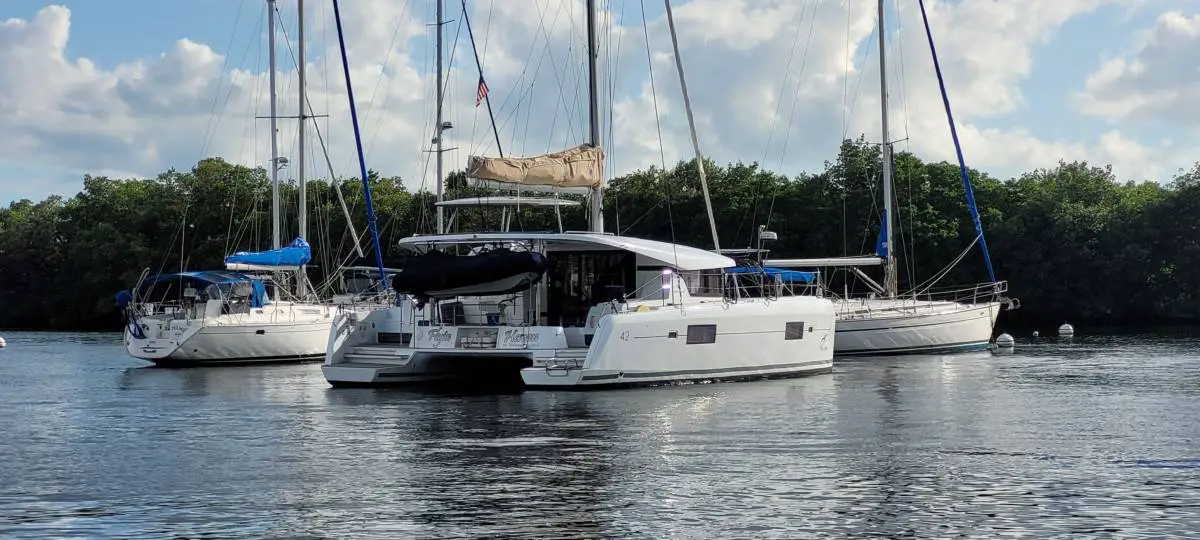
As an Amazon Associate, we earn from qualifying purchases. We may also earn commissions if you purchase products from other retailers after clicking on a link from our site.
Solar panels have become game changers when it comes to supplying power while off the grid. Marine solar panels can charge anything from batteries to computers to bigger electronic appliances. What are the best solar panels for sailboats?
The 9 best solar panels for sailboats are:
- Renogy Flexible Solar Panel
- Newpowa Solar Panel
- SunPower Flexible Sol ar Panel
- Eco-Worthy Off-Grid Solar Panel
- Rich Solar Polycrystalline
- Topsolar Flexible Solar Panel
- HQST Monocrystalline Solar Panel
- WindyNation Solar Panel Complete Off-Grid
- DOKIO Solar Panel Kit
This article will explore everything you need to know about the best marine solar panels.
Table of Contents
Solar Panels on Sailboats: An Overview
Before exploring the best solar panels, it is helpful to consider how solar panels on sailboats work and how many you need. Solar panels sit on different parts of a sailboat’s surface and absorb the sun’s rays, converting them into energy. This energy is used to power chargers, fridges, cooking stoves, and other electronics you need for self-sufficient sailing.
Worth noting is that today we will only discuss solar panels and not the batteries, which of course is an essential part of a complete system; we will also not discuss charges or charge controllers.
The products in this post will get you started in the right direction, but if you’re looking for a high-output system, then I suggest you contact someone that can help you calculate your energy requirements.
How Many Solar Panels Do I Need for My Sailboat?
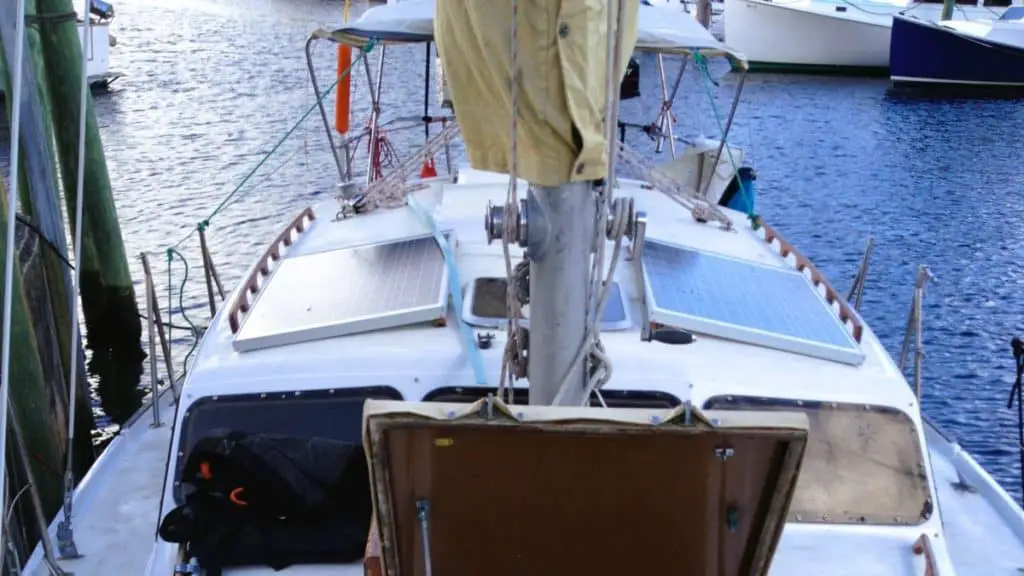
You will need between 2-8 solar panels for your sailboat. The exact amount depends on your sailboat’s space and how many electronics you need to power. Most solar panels can absorb between 100-300 watts per hour. On average, you will need approximately 1500 watts of power each day.
If your solar panels absorb 1500 watts daily, here’s what they can power on your sailboat:
- A laptop charger
- A microwave
- A coffee maker
- An induction cooker
If you want to power more heavy-duty electronics like a washing machine or a television, look for solar panels that absorb 400 watts. For heavy-duty electronics, try installing 5-8 solar panels.
Flexible vs. Rigid Solar Panels
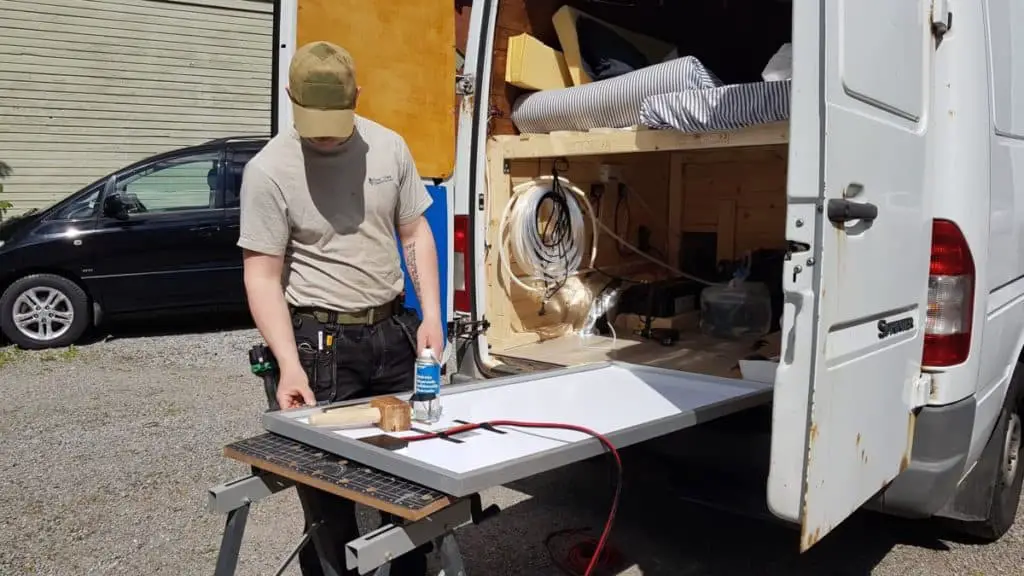
The three main types of solar panels are rigid panels, flexible panels, and semi-flexible panels.
Rigid panels are surrounded by aluminum and made with sturdy tempered glass. They are resilient against various weather conditions but require flat space to install.
Semi-flexible panels can be slightly bent to fit the shape of the installation surface. However, they can’t absorb a lot of power.
One very common type of solar panel used on boats is the flexible panel . Flexible panels are thin and lightweight, and, as their name suggests, they can be added to a wide variety of surfaces.
Here are the pros of flexible panels:
- They are thin and light. Flexible panels are approximately one-eighth the weight and size of rigid and semi-flexible panels. This allows you to add them to various sailboat sizes and surfaces. It also reduces the load on your sailboat.
- They are easy to install. Flexible panels are easy to work with and can be self-installed by following the instructions that come with the panels. Meanwhile, rigid and semi-flexible panels may require expert installations.
- They’re sturdy. Despite being light, flexible panels can bear a lot of pressure – you can easily walk over them.
However, there are also some drawbacks to using flexible solar panels:
- May fly away . As flexible panels are fragile, they can easily be dislodged and fly away, especially in strong winds.
- Vulnerable to scratches . While flexible panels can bear much weight, they may get scratched more easily. Over time this may affect their functionality.
- Not easy to reposition. Flexible panels are generally adhered to the surface of a sailboat using a specially prepared adhesive. Because of this, it is challenging to reposition the solar panels when there is a change of season.
- Less efficient. Flexible solar panels don’t convert energy to electricity or rigid panels. It may be harder to power heavy-duty appliances from a flexible solar panel.
How Many Panels Can I Fit on a Sailboat (Catamaran and Monohull)?
The amount of panels you can fit on your sailboat depends on the size of the panels and the surface space you have available.
You can fit at least two 400W panels on a Monohull and at least four on a Catamaran around 35ft in length. You will be able to fit 4-8 more solar panels if you add a solar panel bracket at the stern.
Renogy Flexible Solar Panel 100W
Renogy is a popular solar panel producer that designs high-quality solar panels. The Renogy Flexible Solar Panel is specially designed for marine vehicles, including sailboats.
Here are the best features of this solar panel:
- Flexibility . These solar panels are fragile, making them flexible and easy to mount on served surfaces.
- Easy to install. These are made with high-quality Monocrystalline, allowing them to be easily bent and easy to install.
- Lightweight. One solar panel weighs only 4 pounds, ensuring that no extra pressure or weight is displaced on your boat.
- Durability . User reviews have noted that these panels are highly durable and can last you a few years.
- Users have noted that these panels do not have the best outputs. They also can’t be stacked, which impacts their accessibility. To ensure that these panels can be connected, you may purchase extra extension cords.
Newpowa Rigid 160W Solar Panel
The Newpowa Right Solar Panel is a new design with a maximum power of 160W. It is weather-resistant and can be used on various surfaces and vehicles.
Here are the pros of the Newpowa Solar Panel:
- Weatherproof . The design features of this solar panel ensure that it survives under a range of different weather conditions. It has a heavy-duty frame preventing it from strong wind and waves. Its mainframe has a further layer of protection for the Junction box.
- Long warranty . Newpowa offers a 25-year transferrable output power warranty.
- Easy to install . These solar panels are made with mono cells and bypass diodes. Consequently, the solar panels can be immediately unpacked and are ready to install.
- High wattage. As these solar panels have 160 Watts of power, you need less of them to power all the devices on your boat.
- If you are planning on buying the Newpowa Solar Panel, you should note that they only make rigid panels. As a result, you may find it to be difficult to install them on curved spaces.
SunPower 110W Flexible Solar Panel
SunPower’s Flexible Solar Panels are made with high-quality materials ensuring durability. They are especially ideal for sailboats as their warranty also covers saltwater damage.
Here are the standout features of the SunPower 110W Flexible Solar Panel:
- Flexibility . This solar panel can be bent up to 30 degrees, making it easy to install on various surfaces.
- Easily portable. These solar panels are incredibly lightweight (4.4 pounds or 2 kilograms) and can be easily uninstalled and transported.
- Extended warranty . SunPower offers a five-year warranty on power and a two-year warranty on the product. The warranty includes damage caused by saltwater which many other solar panel warranties do not.
- Some users have noted that the output quality of these solar panels deteriorates over time. However, you can use the extended warranty to address any quality deterioration.
ECO-WORTHY Rigid 25W Off-Grid Solar Panel
This is a rigid, 25-watt solar panel that is waterproof, making it ideal for your boat. It is highly durable and has inbuilt indicators that highlight the battery’s status. Its low output makes it only suitable for charging phones or smaller electronics.
Here are some notable features of the Eco-Worthy Solar Panel:
- Ease of use. This solar panel is easy to install and requires no maintenance.
- Warranty. Eco-Worthy offers one year of warranty on all of its products and free maintenance if needed.
- USB control. This solar panel is attached to a USB control panel, preventing it from overcharging and getting damaged.
- Waterproof. All solar panel parts are entirely waterproof and can handle exposure to both saltwater and freshwater.
Some of the drawbacks to this solar panel include:
- Low watt absorption. Unlike many of the other solar panels on this list, this one can only absorb up to 25 watts of power at a time. So, it can only power smaller devices like batteries.
- Instruction manual. Some users have noted that the instructions to set up the Eco-worth solar panel are confusing for beginners. If you have never installed solar panels before, it’s best to call in an expert to help.
RICH SOLAR 100W Rigid 12V Polycrystalline
This 100W rigid solar panel is designed to absorb energy even in low light conditions. It is easy to install and ideal for marine environments.
Here’s why you should consider buying Rich Solar Panels:
- Works well in low light. This solar panel has been tested in various low light conditions, including cloudiness and during sunrise and sunset. It is certified to be able to harvest energy in low light conditions.
- Extended warranty. Rich Solar Panels offers a 25-year warranty on limited power output and a five-year warranty on quality.
- Water and weatherproof . The Rich Solar panels have used selective design elements to ensure they are water-resistant. They have high transparency and are made with tempered glass to withstand high winds and water pressure.
- Cost-effective . These are significantly cost-effective, making it easy to equip your sailboat fully.
- While solar panels can easily resist strong winds and water, they can be vulnerable to hail. Hail storms can cause dents on the solar panels, which can eventually cause damage.
Topsolar Flexible 100W Solar Panel
Topsolar provides premium flexible solar panels that are easy to move and install. They are ideal for installing on water vessels like sailboats with waterproof materials.
Here are some of the pros of choosing the Topsolar Flexible Solar Panel:
- Flexibility . The arc radius of this solar panel is 16 inches (40 centimeters) and can be bent to fit several curved surfaces allowing your solar panel to harvest the most sun.
- Efficiency . These solar panels are made with ETFE (ethylene tetrafluoroethylene) materials. They are extremely energy efficient and can rapidly convert energy.
- Some users have noted that these solar panels don’t have as long a life as other panels. In addition, some panels may only be able to absorb up to 75 watts of power at a time.
HQST Rigid 100w Monocrystalline Solar Panel
This is a 100-watt solar panel that has been specially designed to perform well in low light. It is made with high-quality materials and is ideal for sailing boats as it is durable even in unfavorable weather conditions.
Here are the pros of installing the HQST Solar Panel:
- Durability . These solar panels are designed to withstand strong winds and snowfall. They’re made with tempered glass and aluminum and are resistant to corrosion, ensuring longevity.
- Testing and warranty. Each solar panel is quality tested before it is distributed. It also comes with a three-year warranty.
- Easy to install . While these are rigid solar panels, they have pre-drilled holes, making them easier to install.
WindyNation 100W Solar Panel Complete Off-Grid
As its name suggests, this solar panel is designed for off-the-grid living and is helpful if you need to access power when you’re in the middle of the sea.
Here is why you should consider the WindyNation Solar Panel:
- Includes a charge controller. This controller lets you quickly see the amount of power the solar panel has absorbed.
- High power. Several positive user reviews have indicated that this solar panel is highly efficient in absorbing and converting power.
- This solar panel is more expensive than many others on the market.
DOKIO 300W 18V Portable Solar Panel Kit
If you are looking for a heavy-duty solar panel, the Dokio Solar Panel Kit is excellent. It can absorb a lot of energy and power a wide range of appliances on your sailboat.
Here’s why you should consider this solar panel:
- Versatile and flexible. While this is a rigid solar panel, it can be folded, making it easy to transport and install.
- High efficiency. This solar panel is highly efficient at converting energy into power. As it absorbs up to 300 watts, you can install just two of these panels to get significant energy.
- Some users have noted that this solar panel does not work well in low-light conditions. You may want to have a backup solar panel for days when it’s rainy and windy.
Here are Some of My Favorite Catamaran Cruising Resources
Thank you for reading this article. I hope you found it helpful as you hopefully start your sailing adventures. Here are some resources that I use as a sailor that I hope you’ll also find helpful. These are affiliate links, so if you do decide to use any of them, I’ll earn a commission. But in all honesty, these are the exact things that I use and recommend to everyone, even my own family. Sailboats: If you’re looking for the best boat to suit your needs, I would recommend a catamaran. If you’re interested, I can show you the differences between catamarans and other types of sailboats .
Books: For getting started, I really like Cruising catamarans made easy . It is actually a textbook from the American sailing association; it is used to get a cruising catamaran certification. There are some other great books, and I have compiled a list of books about cruising catamarans that you will find useful.
Communication: Being out on adventures, whether it be sailing or climbing mountains, good communications are essential to being safe. I recommend two things Google fi (incredibly simple cellular data all over the world) and Garmin inreach mini (for text and voice in remote areas without cell coverage)
Sailing courses: Online sailing courses are great for beginners starting out their sailing career; it’s an efficient way of learning the basics of navigation, throttle controls, and maritime safety. I suggest starting with two free courses from NauticEd .
To see all my most up-to-date recommendations, check out this resource that I made for you!
Owner of CatamaranFreedom.com. A minimalist that has lived in a caravan in Sweden, 35ft Monohull in the Bahamas, and right now in his self-built Van. He just started the next adventure, to circumnavigate the world on a Catamaran!
Leave a Reply Cancel reply
Your email address will not be published. Required fields are marked *
Save my name and email in this browser for the next time I comment.
Recent Posts
Must-Have Boat Gear for Catamaran Sailors!
Sailing is probably the most gear-intensive activity I've ever done; there are so many decisions to be made about what gear to buy now, for tomorrow, and what to definitely never buy. The gear on...
6 Best Trailerable Trimarans For Bluewater and Coastal Sailing
Having a boat costs a lot of money, even when you are not using it, marina fees, etc. And once it is in the water most sailors never go very far from their "home marina" and sailing will be somewhat...
Hurry up! When it’s gone, it’s gone | SHOP NOW

Robert Posted on May 31 2023

As sustainability becomes an increasingly important consideration for boaters, sailboat owners are turning to solar power as a reliable and eco-friendly solution to meet their energy needs. With advancements in technology, installing solar panels on a sailboat has become more practical and efficient than ever before. In this blog post, we will explore the benefits of solar power on a sailboat and provide a step-by-step guide on how to install and optimize your solar panel system.
1. Why is Solar Power Useful on a Sailboat?
Sailboats offer an ideal environment for harnessing the power of the sun. Unlike motorboats, sailboats rely on wind power for propulsion, making them more energy-efficient. By installing solar panels on your sailboat, you can generate electricity to power various onboard systems, including lighting, navigation equipment, refrigeration, and electronics. Solar power eliminates the need for noisy generators and reduces your dependence on fossil fuels, providing a quieter and greener boating experience.
2. Installing Solar Panels on a Boat
a) Mounting:
Before you begin the installation process, carefully select the mounting location for your solar panels. Ideally, the panels should be placed on a flat and unobstructed surface on the boat, such as the cabin roof or deck. Ensure that the mounting location allows for easy access and does not interfere with the boat's rigging or sails. b) Positioning Your Solar Panel:
To maximize solar energy production, it is essential to position your solar panel correctly. Ideally, the panel should be oriented towards the sun to receive optimal sunlight throughout the day. If possible, angle the panel to match the latitude of your location, as this will help maximize energy capture. Additionally, ensure that the panel is not shaded by any obstructions, such as masts, sails, or other equipment, as shading can significantly reduce the panel's efficiency. c) Wiring Your Solar Panels:
To connect your solar panels to the onboard electrical system, you will need to run wiring from the panels to the battery bank. Use marine-grade solar cables and connectors that are designed to withstand the harsh marine environment. Ensure that the wiring is properly protected and secured to avoid damage from vibration or exposure to saltwater. It is recommended to use conduit or wire ducts to keep the wiring organized and protected.

3. Cabling and Connector Considerations
When choosing the cables and connectors for your solar panel system, consider the following factors: a) Cable Size: Select the appropriate cable size based on the distance between the panels and the battery bank. Longer cable runs may require larger gauge cables to minimize voltage drop and maximize efficiency. b) Connector Type: Use high-quality connectors that are specifically designed for marine applications. Ensure that the connectors are waterproof and corrosion-resistant to withstand the marine environment effectively. c) Fuse or Breaker: Install a fuse or circuit breaker between the solar panels and the charge controller to protect the system from potential short circuits or overloads. This safety measure helps prevent damage to the panels or the onboard electrical system.
4. Choosing the Right Charge Controller
A charge controller is a crucial component of any solar panel system, as it regulates the charge going into the battery bank. When selecting a charge controller for your sailboat, consider the following factors: a) Type: There are two main types of charge controllers: PWM (Pulse-Width Modulation) and MPPT (Maximum Power Point Tracking). MPPT controllers are more efficient, especially in low light conditions, and can increase energy harvest by up to 30% compared to PWM controllers. b) Capacity: Ensure that the charge controller can handle the maximum output of your solar panel system. Consider the wattage of your panels and the voltage of your battery bank when choosing a charge controller with the appropriate capacity. c) Monitoring and Protection: Look for charge controllers that provide comprehensive monitoring and protection features, such as battery voltage display, overcharge protection, and temperature compensation. These features will help optimize the performance and lifespan of your battery bank.
5. Conclusion
Installing solar panels on a sailboat is a sustainable and cost-effective way to power your onboard systems. By utilizing the sun's energy, you can reduce your reliance on fossil fuels and enjoy a quieter and more eco-friendly boating experience. Properly mounting and positioning your solar panels, along with careful consideration of cabling, connectors, and charge controller selection, will ensure a successful installation and optimized energy production. Embrace solar power on your sailboat and embark on a greener boating journey. Remember to consult with a professional or an experienced marine electrician before proceeding with any installation to ensure compliance with safety regulations and best practices.
Leave a comment
All blog comments are checked prior to publishing
Subscribe to our newsletter
Signup for our newsletter to stay up to date on sales and events.
Join our mailing list
Signup for updates!
*By completing this form you're signing up to receive our emails and can unsubscribe at any time.
- Sign in / Register
- Comparison list
- Solar on the go
Picking the best solar panels for a sailboat: Buyer’s guide
- 18 Aug 2022

You might have already heard of brave sailors that conquer the oceans with nothing but wits and solar panels. For instance, this year 83-year-old Kenichi Horie became the oldest person to sail solo from the US to Japan on a solar-powered boat. These stories are inspiring, but picking panels for your boat yourself can be a small challenge in itself. That’s why we wrote a short article about the best solar panels for sailboats and how to recognize them.
Start from type of solar panels
When it comes to solar panels for sailboats, their weight and size matters more than with PV modules for residential systems. Efficiency is important but power — not that much, because the energy needs of a boat are relatively low. The first thing you’ll have to decide about your panels is their type.
Generally, you’ll choose between thin-film panels and monocrystalline modules. While polycrystalline panels are still around and they are indeed cheaper than mono panels, they are much less efficient, which means they’ll need more space and add more weight to your boat.

Thin-film panels are light and cheap
Thin-film or flexible solar panels bend well and they are very easy to install which makes them a great choice for boats with difficult configurations. Some sailors say that flexible panels are the best choice for fast boats because they don’t impact the aerodynamics of a vessel as much as rigid panels do.
The downside of flexible panels is their low wattage. If there are many appliances on board, you’ll need several panels and you’ll need to find the right place for each of them. They also age faster than rigid panels — a thin-film panel generally lasts for 10-15 years.
Monocrystalline panels are powerful and reliable
Rigid solar modules, monocrystalline and polycrystalline, are heavier and bulkier than thin-film panels. You can fix flexible panels with adhesives, but rigid panels require drilling. They are also more expensive than flexible panels.
On the other hand, monocrystalline panels are the most efficient type of panels which means that they provide more power for less space. Even one powerful mono panel can be enough for everything that you’ve got on board. They are also much more reliable and will survive any storm that is coming your way. A monocrystalline panel lasts for at least 25 years.
Panels for boat should be efficient and sturdy
The best solar panels for sailboats don’t have to be powerful, but they better be efficient — find the number in the datasheet. For rigid panels anything over 18-19% is fine. Panels also should be sturdy enough to withstand seastorms. You generally also want good shading tolerance since panels often get shaded by masts and sails. Finally, good performance in low-light conditions is appreciated.
Picking bifacial panels, 72/144-cell panels or larger, anything too powerful generally doesn't make a lot of sense. Performance at high temperatures matters less than it does with home systems. Warranties also play a lesser role. You won’t be able to make use of them because they generally have effect only for residential installations.
The markets of thin-film and rigid panels are different. Generally, a manufacturer of flexible panels doesn’t offer mono- or poly-panels. Canadian Solar, Q CELLS and Jinko Solar are good choices when it comes to monocrystalline modules for boats. Renogy , WindyNation and PowerFilm make fine thin-film panels.
Do the math before purchase
The amount of power for your boat depends on the number of appliances on your board. There are two main ways to determine the size of installation that you need. You can take a test trip and see how much of your battery’s charge you’ve spent in one day. You can also do the calculations manually: write down all the appliances on the board with their power rating and number of hours in use per day. You can read about it in detail in our article " How much solar power to sail the seas? " It doesn’t make sense to oversize a marine PV system, because all the excess power will just go to waste.
Keep in mind that adding photovoltaics doesn’t make your vessel a solar boat, unless you have a solar-powered motor. You can switch your boat to solar energy fully, especially if it’s small, but you’ll have to calculate your energy needs accordingly.

Once you’ve purchased your panels, you’ll have to install them properly. You can order professional service or do it yourself. The most popular places for solar panels on a boat are a stern rail, masts, deck and canvas. Thin-film panels can even go on the sails. Ideally, you want a place where panels wouldn’t be shaded by masts on any other parts of a boat.
List of solar panels for a sailboat
We’ve asked our engineer to pick the panels that would complement a small boat well. These are his choices:
ZNShine Solar ZXM6-NH120-370/M

Solar panels from ZNShine Solar are inexpensive and fit all kinds of applications, including boat systems. ZXM6-NH120-370/M provides 370 Watts of power with a 19.88% efficiency. It performs well in low-light conditions. Graphene coating increases power generation and allows self-cleaning. The only downside is a lower wind tolerance, compared to other models: it is rated to withstand 2400 Pa pressure which is comparable to 140 mph wind.
Mission Solar MSE345SX5T

MSE 345 is a simple solar panel for all kinds of applications, including boat installations. Mission Solar panels are manufactured in Texas. The module provides 345 Watts of power with 18.7% efficiency. It is certified for high snow (5400 Pa) and wind loads (4000 Pa). The model is resistant to salt mist corrosion.
Suntech STP 365 S

Suntech is a Chinese company that offers quality budget-friendly solar panels. The STP365S model stands out in line because of its great performance in weak light, such as cloudy weather and mornings. It is designed to withstand harsh weather conditions, and the module is certified to tolerate wind of over 170 mph. Half-cut design makes cells sturdier and improves shading tolerance. Overall, this panel earns a place among the best boat solar panels.

Andrey had been a news editor and freelance writer for a number of medias before joining A1SolarStore team. Climate change and its impact on people's lives has always been among his interests and it partially explains his degree in Philosophy and Ethics.
Point Zero Energy solar generators review: Titans
Solar monitoring systems: All under control
Inergy solar generators review: Taking charge
AC vs DC-coupled solar battery systems: Pros and cons
How to clean RV solar panels
Learn about the latest arrivals and discounts first!
By clicking "Subscribe", I agree by electronic signature to: (1) receive marketing and other texts and messages from A1SolarStore, directly or from third parties acting on its behalf, at the email address I entered above; (2) the Terms and Conditions ; and (3) the Privacy Policy .
Captain Curran's sailing blog
~ a collection of sailing adventures from Alaska to Cabo
October 6, 2014
Solar panels for boats: an easy installation guide., marine solar panel installation.
- I am writing the following instructions for boat people or RV campers.
- I describe a basic set up that provides a charge onto your 12 Volt DC battery bank.
- If you want to use this system to power your home, then you'll also need an inverter to switch the 12 Volt DC electricity to 110 Volt AC.
Ok, here's my simple DIY instructions for solar installation on a boat or an RV camper.
How to install solar panels for boats.
| my 30 watt solar panel on the stern railing of my boat |
Step by step guide for installing a solar panel boat system
Faq: what size panel should i get, faq: which brand of solar panel is best, faq: do i need a controller.
| the SunSaver-10 controller mounted in my cabin |
FAQ: How did you mount your panel on your stern rail?
| the backside of my solar panel showing stern rail mounts |
FAQ: How do you wire up the panels/controller/battery?
| marine grade copper wire for 12 volt DC electronics |
| zip ties snugging up the wires to keep them from getting fouled |
| one set of wires coming in from the panel, another set going out to the battery |
| incoming positive wire attaches to positive terminal... |
FAQ: How much will this whole solar panel project cost?
Solar power for boats price breakdown, okay - good luck with your marine solar panel installation , capt. curran, 64 comments:.
Heany - Don't hesitate, the beauty of this system is that there are no moving parts, which means maintenance is minimal.. turning photons to electrons
Good question - visit your local machine shop They should have barrels of aluminum flat panels You want 12-16 inch long, need to measure panel That's it Then drill holes and strap in on the rail Have fun!
Thanks Douglass - all the best..
Great information, thank you! Where did you purchase the white plastic rail mounts?
Hello Philip Magistro, I bought them at a boating store in Seattle - called Fisheries Supply - they may ship. But I would also check your local west marine - they are standard stern rail mounts - they fit lots of other stuff as well as solar panels. Good luck !
Excellent, glad it was helpful. I'm about to post a couple new photos of the system. Everything is still working great.
Two questions 1. Is a 30w panel large enough to trick charge two 12v batteries? 2. How large an in-line on the positive lead to the battery?
Hello - Yes, a 30watt panel is large enough to trickle charge 2 12 V batteries. That is the set up I have on my boat - it works great - even in mixed sun/cloud conditions. When you ask 'how large' an in-line on the pos. lead - I am assuming you're asking the guage. I can't give the exact guage that is suited for your set-up. But, I know that the reasonable range is between 10-14 awg. Hope that helps.. Cheers
Kevin Thanks. Great info! I was actually trying to ask type and size of fuse on the positive lead to the battery. Fingers! Cheers Bill Pierson
Thanks for a great post! I'll go with the Renogy 200 Watt kit. I know it's not as adventurous, but easier and faster. And time is money :)
Lucas, I hear ya. Time is money - best of luck with that kit. I think you've made a wise decision.... Kevin
Thanks a lot Kavin for your guidance on installing a solar panel on boat. As solar panels are the most effective and the best way of generating electricity these days so everybody wants to install a solar panel of their own. But installing a solar panel in the boat is little challenging. Thanks for sharing the step by step guidelines, it is definitely going to help the readers.
Great article. A few questions: The article explains how to hook it up to one battery. But I have a system with two house banks of two bateries each, as well as a starter battery. How do I ensure that the trickle charge gets to all give batteries? Or do you just hook it up to the starter battery? How does this system interact with my charger?
Mary, I have a similar battery bank - but the two are connected. I connect the leads of the solar panel to my house batteries. However, if they are not connected - then I would connect the leads of your solar panel to the starter battery.
Mary, I would get a MorningStar SunSaver Duo controller which can charge 2 batteries (or banks thereof) and set the 2 house banks in parallel on the controller's Batt1 and the Starter Battery on Batt2. This controller has the option to charge 90/10 or 50/50, 90/10 is best for this setup because the starting battery doesn't need much, just enough to top-it-off.
Hi Kevin, I purchased the Renogy 100w panel with controler. I like your plastic rail mounts. Where can I find those. I plan to mount this on the stern of my 73, 27' Catalina stern rail. Thanks, Chris
Chris, I got mine at a boat store in Seattle called Fishery Supplies. I just looked it up on their website. Here's the page for those rail clamps. https://www.fisheriessupply.com/sea-dog-line-removable-rail-mount-clamps-327199-1 Made by a company called Sea Dog. Good luck - Kevin
I have a 20 volt panel, single marine battery, with a controler working without problem for about 4 years. While motoring out of the marina the controler caught fire. I did not have a fuse installed as you described in your installation guide. Any idea what might have caused this? Barry
Barry Curran, That is an odd and unfortunate situation. I am not an expert on safeguarding circuits, however I can weigh in with my opinion. I do think that the installation of a circuit fuse would help prevent over-charge or over-heating happening within the circuit. I think - assuming the over-charge was happening throughout the circuit - that the fuse would have blown, thereby salvaging your controller. However, there is a chance that a diode or some other internal circuit on the controller was the weak link. In that case, I don't believe a downstream fuse would have helped save your controller. I would install a fuse and get yourself a new controller. Best of luck! Kevin Curran
Just an helpful clarification on the purpose and location of the fuse. The fuse is to protect the wire, and should be placed as close to the origination of the power source as possible which, in this case, is the positive lead near the solar panel. We're all use to hearing about locating the main fuse on a boat as close to the battery as possible; that's because that's where the power comes from. Also, the fuse should be sized based upon the length and gauge of the wire.
Thanks for that additional insight on the location of the fuse! Sorry I didn't see this comment earlier.
Thanks for sharing the helpful guide to install solar panels .
Thanks for sharing article solar installation on boats it is really informative.A Solar panel is typically a panel that absorbs solar energy and uses it as a source of energy to generate electricity. They are basically made up of solar cells or the photovoltaic cells that are arranged as a photovoltaic array making up the photovoltaic system.I know a place one of the best solar installation company provides best solar services and products that are not just economical, but also efficient with customized solutions to offer you the best from our vast range of affordable models...
Greetings, How lucky am I to have happened upon your easily understood blog. Stupid question: can I mount the solar panel flat on the deck of my Nonsuch sailboat? (I know: don’t step on it!). Will it be worthwhile? (It can’t go on the stern rail).
Yes, that can be done. If you have a bimini or any cover in your cockpit, that is probably a better location. But flat on the deck can work, you can create a border around it to prevent falling on it...
Thank you so much for your excellent blog. I am considering a solar system for my 28' Catalina sailboat. Battery question: Any problem using solar systems with AGM batteries? I have two, house and starter battery.
Hmmm, that's a good question. I have never heard of any issue with AGMs on a solar system. Any other readers here have comments?
Selecting the correct charger depends primarily on the design of your deep cycle battery, so the first thing you need to do is determine the construction type of your battery. TrollingBatteryAdvisor.com This is likely to prolong the life of each battery and save you money in the long run.
Great blog! Can I leave my solar panel attached to the battery while I'm drawing from the battery to run my trolling motor?
Anonymous, Yes, you certainly can. There is no issue with drawing from a battery that is being fed energy from a solar panel. Enjoy Captain Curran
Thanks for sharing this article here about the solar panels for boats . Your article is very informative and I will share it with my other friends as the information is really very useful. Keep sharing your excellent work.
Great to hear! Glad the post was helpful..
Thanks a lot, Captain Curran and co-Captain Jessica for a nice and informative article about "Marine solar panel installation". This article will surely help the sailor in the Sea. And using a solar panel in the mid-sea is a very nice idea as an alternative source of power. Best wishes from SolarPandit
Thank you very much, Captain Curran and co-Captain Jessica, for a very interesting and insightful post on "Marine solar panel installation." This article will undoubtedly assist the sailor at sea. Using a solar panel and in the middle of the sea as an alternate source of electricity is also a great idea.
Hello all, Great to see the article has been helpful for those putting panels on their boat. Don't hesitate to reach out with any questions. I changed the notification, so I should be pinged when someone asks a question. Fair winds!
The Renogy 30 Watt Solar Panel is an excellent choice for light energy users, while the 100 Watt Solar Panel is preferred for moderate energy users. And remember to use a suitable quality controller like the Morningstar SunSaver-10 to control the panel's charge and prevent over-charging the battery.
Their step-by-step guide for installing solar panels on boats is incredibly helpful, and I appreciate the personal touch of sharing their own experiences and the success they've had with their solar panel system. The detailed explanations, recommended products, and estimated costs make it easy for someone like me to envision completing this project over a weekend. I'm definitely inspired to take on this DIY installation and enjoy the freedom of generating my own energy while sailing.
I can’t really help but admire your article your topic is so adorable and nice.
Forbidden love in a mesmerizing supernatural universe. Anime like Devils Line
Captain Curran's guide to installing solar panels on boats is a real lifesaver! After following his easy-to-understand steps, I completed my own installation over a weekend, and now my boat's batteries are always topped off during my fishing trips in the Chesapeake Bay. No more worries about a dead battery spoiling the fun!
Hello Captain, Great article, thank you. Our vessel has (6) 6 volt golf cart batteries, a 2000 Watt inverter, plus a generator. I want to limit the generator recharge time by installing a 100 or 200 watt kit that you recommend. My question is can I just connect the pos. and neg. marine grade wires from the controller directly to my battery bank pos. and neg. Thanks, John
This article on installing solar panels for boats brought back memories of my own sailing adventures along the coast of California. I remember the frustration of being stranded due to a dead battery and the relief that came with finding a solution. Capt. Curran's step-by-step guide is not only practical but also reflects his passion for sustainable energy solutions, making it a valuable resource for fellow sailors.
Mr gorelal Ramlal Nagpur Maharashtra
Hamen bhoot kharidna hai price bataen contact Karen
Usko use karne ka Tarika bataen aur iske future bataen liya to aapka contact number bhejen message Karen share Karen
Hello Capt. I want to limit the amount of recharge time on my boat. I installed a 100 watt Renolgy panel, controller, correct gauge wire, and fused both positive leads properly. My house batteries are (6) golf cart batteries, 1200 ah, 12 volt output. What are your suggestions for connecting the controller pos and neg terminals. Thanks, John
Post a Comment
How To Install Solar Panels on A Sailboat
We may collect a share of sales from items linked to on this page. Learn more .
Make the most of the sun’s energy when you’re out on the water by installing solar panels to your sailboat!
This is an in-depth video on how you can install a solar panel system on a sailboat – in this case, a 300W solar system was sufficient for a 38′ catamaran “Zingaro”.
Greener Ideal helps you live your life in more sustainable ways with green living tips and commentary on the latest environment news. We want to protect the planet and reduce our collective carbon footprint.
View all posts
What do you think? Leave a comment! Cancel reply

Tips for Making Your Storefront Energy Efficient

Solar Panel Deal for Earth Day from Bluetti
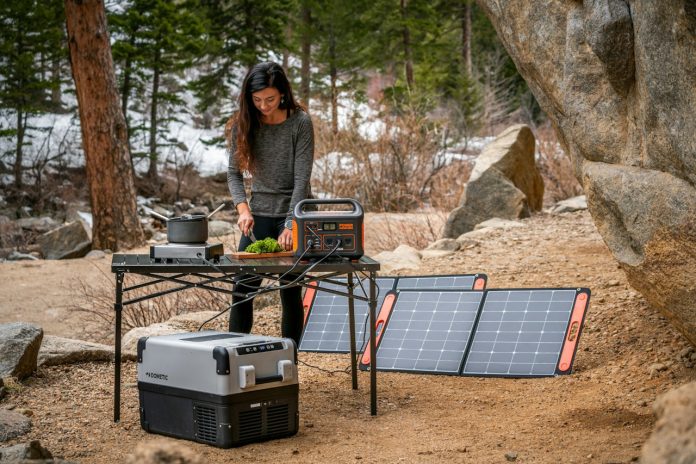
Solar Energy Trends to Watch in 2024
Popular today.

The Rural Shift: Balancing Sustainability in Country Living

Can Regular Air Quality Checks Lead to Energy Savings?
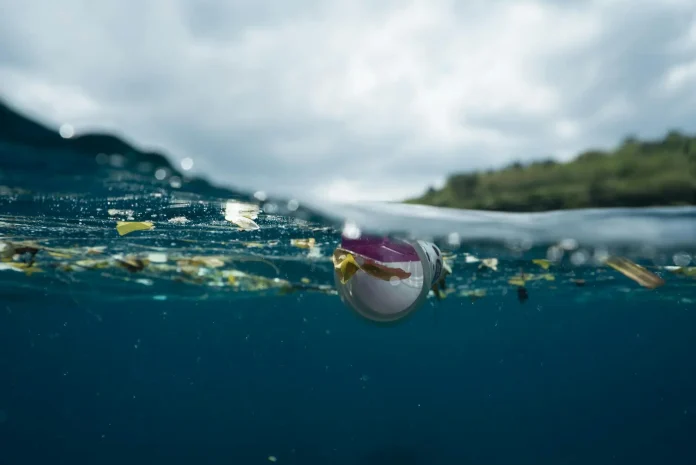
5 Surprising Ways Ocean Pollution Affects Human Health

Greener Ideal helps you live in more sustainable ways with green living tips, commentary on the latest environment news, green product reviews, healthy recipes, and more.
We strive to protect the planet and reduce our collective carbon footprint.

Bridging Convenience with Sustainability in Modern Diets

8 Insta Tofu Recipes That Will Melt Your Tastebuds

Why Decreasing Greenhouse Gas Emissions in the Kitchen May Come Down to Evaluating the Thermodynamic Properties of Your Cookware

The Environmental Impact of Disposable Tooth Flossing Picks: Time to Consider Sustainable Alternatives

© Copyright 2024 - Greener Ideal
FEATURED PRODUCT - MADE IN THE USA ULTRA HIGH EFFICIENCY BI-FACIAL RIGID PANEL KITS
(800) 788-2322 [email protected]

- SUNPOWER Semi-Flex Kits
- RIGID Mono Kits
- Marine Solar Panels
- Portable / USB Chargers
- Controllers & Accessories
- Inverters / Chargers
- Lithium and AGM Batteries
- Customer Testimonials
- Customer Installations
- Manuals & Specifications
- Owner's Blog
outstanding customer service and unbeatable prices
Customer Reviews

Marina, Dealer, and Consumer Services member
All installations are done by our highly skilled abyc certified technicians.

Imagine the freedom of endless power
Chris purchas - founder and managing director, peter van tienen - director of sales and service.
Chris has always been an early adopter of technology and thought it would be amazing to be able to spend endless days out on the water without having to run the generator. Being on a boat at anchor is a place to relax and unwind, that loud reverberating noise from the generator just crushed the mood.
Marine Solar Innovations Inc. was created offering innovative high quality products, competitive pricing and better service than any other enterprise in this area. Our company goal is to offer the boating and RV community "Outstanding Customer Service and Unbeatable Pricing" .
Direct Contact:
1-800-788-2322 EXT 700
Peter is an entrepreneur and technical specialist, spending 30+ years in the education and tech industries. He is an ABYC certified technician , Garmin certified installer and a Raymarine tech. Peter has always been an early adopter of technology and has a keen focus on smart boating and monitoring.
He has substantial knowledge and experience with Victron Energy systems and has completed numerous marine electrical installations within Southern Ontario. He is an avid boater with vast experience in marine electrical systems and provides training and support to our dealer network and marina partners. Our company goal is to offer the boating and RV community "Outstanding Customer Service and Unbeatable Pricing" .
1-800-788-2322 EXT 701
about our products
How does a solar charging system work.
- A solar charging system works exactly the same as your on-board house battery charging system. The big difference is that the solar battery charger is powered by the sun instead of shore power or a generator.
- The solar charge controller is a full multi-stage battery charger that provides a bulk, absorb and float charge cycles, keeping your onboard battery bank in tip-top condition when you're away from shore power.
- Depending on the configuration, a solar charging system can provide between 6 to 50 amps of power, all harnessed from the solar panels installed on your boat. This charging power replenishes the energy drained by fridges, lights, stereos, inverter loads, wash-down pumps etc. This natural charging cycle means that your battery bank is never depleted, you can stay on your boat away from shore power for indefinite periods of time, using all of your on-board electronics freely without worrying about battery drain.
- A Solar Charging System will significantly extend the life of your battery bank as it virtually eliminates the risk of detrimental deep discharges and keeps the charging cycles within the optimum ranges.
- Best of all, it's noise and pollution free !
What are Inverters or Inverter/Chargers?
- Most boats have a stock DC system which supplies power at anchor from a dedicated house battery bank. A DC power system can supply energy to operate lights, refrigeration, navigational instruments, water pumps etc.
- An inverter is a device that simply converts DC power to AC allowing you to operate larger higher power devices such as laptop computers, televisions, coffee makers, microwave ovens, toasters, blenders etc.
- Without and inverter, these AC devices require you start up the generator, if your vessel is equipped with one. The inverter affords you the ability to operate these AC devices directly from your DC battery bank. When mated with a solar charging system, the power used by the inverter is easily replenished by the solar giving you virtually limitless power. Many of our customers really appreciate the ability to make coffee in the morning and watch TV at night without running the generator.
- Keep in mind that generally speaking, you cannot operate air conditioners, water heaters, or other devices that have super high current loads.
- An inverter/charger is a very popular option as it combines an inverter with a high powered charger. This allows you to quickly recharge your battery bank when connected to shore power or operating your generator.
What are Battery Monitor Kits?
- Battery Monitor Kits are super easy to install and provide a ton of functionality at a very reasonable price. They are programmed with your battery bank specifications and using that information, they calculate and display a realtime state of charge and current flow.
- These are especially useful when a solar charging system is installed as the battery voltage is no longer an accurate measure of the battery's state of charge. When a solar charging system is charging, the battery voltage is inflated, giving the user a false nexus to the actual state of charge. A battery monitor will always provide an accurate state of charge reading even when the solar is charging the battery.
- Battery Monitor Kits can also be programmed to notify you if your house or starting battery falls below a pre-defined threshold. This provides for a stress free boating experience.
- We offer two versions of battery monitor kits. The Victron BMV-712 displays it's data on a physical screen and via bluetooth. The Victron Smart Shunt displays it's data via bluetooth only. Both are equally reliable and offer the same functionality, one has the additional option of a physical screen.
How do our innovative products differ from the competition?
- We are boaters, all of our systems are designed and engineered for the marine environment. All components are rigorously tested to ensure 100% compatibility . We use our solar systems every weekend and we are continuously conducting research and development on how to improve the operation and efficiency to offer our customers the best possible experience.
- Customer service is our #1 priority. We encourage our customers to do their due diligence and research. Our customer testimonial page provides numerous examples of what our customers have to say about our reputation within the boating community.
- We offer the largest selection of solar panel kits and marine installation options in the industry. From portable systems to fixed permanent installations, we have a solution for every boating application.
- Authorized dealers for major industry brands such as Sunpower USA, Victron Energy, Solbian, Battleborn, Volthium and EPEVER , we offer our customers a comprehensive solution for every application.
- Our semi-flexible panels are of the highest quality, manufactured in a state of the art ISO9001 facility. We use only SunPower USA Premium Quality solar cells providing you with the most efficient performance. Be careful of panels purchased on eBay or Amazon, they use low grade cells which are discounted due to cracks and imperfections. Although the panels look similar, the cells are much less efficient resulting in very poor performance.
- All of our solar panels are tested at the factory and our customers receive I-V Curve and EL reports detailing the performance of the specific panels they purchase.
- Don't be fooled by creative cosmetic finishes and other gimmicks designed to disguise sub-standard build quality and internal components. All premium quality solar panels will utilize Ultra High Efficiency SUNPOWER cells backed by a solid warranty that gives the customer the assurance that they are purchasing a premium quality product
- We offer the full line of Victron Energy products which provide a comprehensive ecosystem of devices that share data, interfacing with striking visual displays and remote monitoring options.
2024 BOAT SHOW Featured Products
We use only premium quality cells in our panels, dock link members receive an exclusive discount ask us for details, browse our marine solar kits, we look forward to hearing from you, marine solar innovations inc..
(800) 788-2322
Drop us a line!
This site is protected by reCAPTCHA and the Google Privacy Policy and Terms of Service apply.
Copyright © 2018 Marine Solar Innovations Inc.
Designed by MSI Web Development Team
- Privacy Policy
- Terms and Conditions
- FL data explorer
- Pinellas County
- Solar companies in Saint Petersburg, FL
Best solar companies in Saint Petersburg, FL: Our 2024 picks
Get the most out of your solar panels by choosing a top-rated solar installer that will do the job right. We reviewed Saint Petersburg, FL solar companies on the EnergySage Marketplace to help you find the best one to install your system.
See your solar savings
Compare multiple offers and save up to 20%
Why you can trust EnergySage
The data on this page comes from real solar quotes to real solar shoppers on the EnergySage Marketplace. We give you access to transparent information so you can confidently make informed energy decisions. Learn more about how our Marketplace works and how we make money.
Any major home improvement project requires a skilled contractor. Solar's no different. In fact, choosing a high-quality solar installer is crucial to getting a system that actually performs well and saves you money.
But Saint Petersburg, FL has 25 solar companies available on the EnergySage Marketplace alone––so how do you choose the best one?
Ranking solar companies is our bread and butter. We screen every solar company before allowing them to join our platform to ensure they'll deliver top-notch installations. With that in mind, here's our ranking of the top five solar companies in Saint Petersburg, FL based on ratings, reviews, and more.
The best Saint Petersburg, FL solar companies in 2024

See the cost of solar in Saint Petersburg, FL
How we rank solar companies.
Our Marketplace has provided hundreds of thousands of quotes to homeowners from solar installers across the country—so we have the data to help you find the best one for you in Saint Petersburg, FL.
Based on this information, we created a tiered ranking system to evaluate solar companies. It focuses on three key areas:
Results , based on success with real customers–from quotes to installation.
Reputation , based on ratings and reviews.
Responsiveness , based on how quickly they respond to questions and requests.
The ranking system includes four tiers of installers: Approved, Advanced, Elite, and Elite+. If a solar company doesn't meet the Approved criteria, they aren't allowed to join our Marketplace.
Elite+ installers are the most experienced, chosen, and celebrated companies on the Marketplace, having provided exceptional service to a high volume of shoppers for at least a year.
Elite installers earn top ratings from customers, endorsements from vendors, and win customers more frequently than their peers.
Advanced installers are among the top half of companies on the Marketplace for responsiveness, reputation, results.
Approved installers passed our rigorous screening criteria for experience, licensing, and positive reviews.
We also recognize installers annually for standout customer service through the EnergySage Installer of the Year awards.
How to pick the best solar installer
There are plenty of reputable solar installers out there. How can you distinguish the best from the rest? We consider the following questions before allowing installers to join the EnergySage Marketplace.

Do they quote high-quality equipment?
High-quality installers care about their reputation. They want to install equipment that performs well and will last a long time. If you get quotes with equipment that you can't find much information about, that's a red flag.
To get a sense of whether the equipment is trustworthy, first make sure it's included in EnergySage's solar panel , inverter , or battery equipment guide–and then see how we rate it relative to other equipment.
You can also check to see if the installer has any manufacturer endorsements , which attest to their expertise installing that brand's products. Most manufacturers require installers to go through a vetting process to ensure they're appropriately licensed and qualified before handing them an endorsement. The endorsements often come with perks that are passed onto customers, like preferred pricing or extended warranties.
See our list of the best solar panels .

How does their warranty compare to other installers?
In the unlikely event there’s an issue with your solar panel system, it’s important to know who to call. Multiple warranties come with your solar panel system, including manufacturer warranties for the various equipment and your installer's workmanship warranty.
The workmanship warranty covers all the labor your installer performs. It's typically somewhere between one and 10 years. But make sure to read the fine print because sometimes there are exclusions: You don't want to be stuck with a hefty bill if your installer needs to come out to check on or replace some equipment.
How many years of experience do they have?
Solar is a growing industry that attracts contractors from many backgrounds—sometimes only loosely related to solar. But to feel confident in your solar panels, you'll want to work with an installer that has plenty of experience in custom designing systems.
At EnergySage, we verify that all installers have at least two to three years of legitimate experience designing and installing solar panel systems before we let them join our Marketplace. We also confirm they have multiple successful installations under their belt.
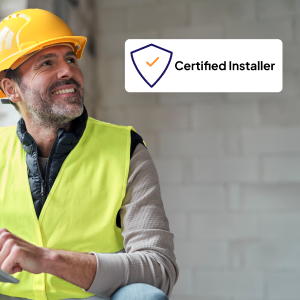
Are they licensed, insured, and certified?
Having the proper licenses and insurance policies is the bare minimum requirement for solar installers. But different states require different policies for solar installers. Sometimes even local jurisdictions have their own requirements. It can be difficult to keep track on your own, which is why we ensure our installers meet all qualifications in the areas they serve.
Certifications aren't necessarily required, but are a great way to weed out lower quality installers. The North American Board of Certified Energy Practitioners (NABCEP) offers an industry-leading certification program, while the PV Installation Professional (PVIP) Board Certification is the gold standard for solar installers.
Certification isn't a firm requirement for EnergySage installers, but it's highly recommended. If the installer started working in the solar industry before NABCEP was formed in 2002 and has a long (and positive) track record, we may still allow them to join our Marketplace.

Do they use subcontractors?
Some solar companies rely on subcontractors to perform some–or all–the work during your solar installation. Don’t let this put you off: It’s entirely standard procedure in the industry.
What is alarming, though, is a lack of transparency from installers about who will install your system and why they use subcontractors.
When you’ve narrowed down your list of potential solar installers, be sure to ask who will install the system: their own crew, or subcontractors. If they use subs, ask why, what portion of the install the subcontractors will complete, and what oversight the company you purchase your system from has over the subcontractors.
At the end of the day, the most important question is who will stand behind the quality of your installation.

Do they have good user reviews?
The fastest way to evaluate an installer's reputation is to look through reviews from actual customers. How many 5-star ratings do they have? Are there complaints about responsiveness? EnergySage, Google, Reviews.io, Reddit, and Yelp can all be good places to look for reviews.
Just keep in mind that reviews don't always paint the complete picture. They often focus on extreme ends of the customer experience, whether that's good or bad.
Check out some user reviews from verified EnergySage customers:
Step-by-step guide
How to install solar panels.
Getting solar panels installed takes time—especially if you're working with a quality installer in high demand. Here's a general outline of what to expect , from choosing a solar company to powering your home with solar energy.
Compare quotes and sign a contract with a solar installer.
Your installer conducts a site visit, either at your house or virtually.
Your installer fills out and submits any required permits and documents and orders your equipment.
Your solar panel installation takes place over one to three days (on average). Installation day includes preparing your roof with racking, setting up wiring, placing panels and inverters, and attaching everything.
A representative from your town government inspects your system and provides approval for interconnection.
How much does solar cost in Saint Petersburg, FL?
Based on the latest data from the EnergySage Marketplace, the average Saint Petersburg, FL homeowner needs a 12.66 kW solar panel system to cover their electric bills. That'll set you back about $29,160 before incentives.
Need a bigger (or smaller) system to offset your electricity use? The average price per watt of solar power in Saint Petersburg, FL is $2.30/W.
These prices are before incentives. After the federal solar tax credit, the final cost will drop by 30%, down to $20,412 for a 12.66 kW system. Many states even offer local rebates and incentives that lower the price further––sometimes by thousands of dollars.
While solar is expensive, it often pays off. The average Saint Petersburg, FL homeowner will save $50,091 over 20 years on electric bills by going solar. The best part is that your system will pay for itself in an average of just 7 years. Then, you'll produce free electricity for years to come.
To learn about Saint Petersburg, FL solar incentives or get a customized savings estimate using our Solar Calculator, check out our solar resources for Saint Petersburg, FL homeowners:
Common questions about Saint Petersburg, FL solar installers
What are the best solar companies in saint petersburg, fl.
According to solar shoppers on the EnergySage Marketplace, the top five solar installers in Saint Petersburg, FL are Solar Optimum, Affordable Solar, Roof, & Air, ProSolar Systems, Transform Solar, and BeeGreen Solar & Roofing
How many solar companies are in Saint Petersburg, FL?
There are 25 solar companies in Saint Petersburg, FL on the EnergySage Marketplace.
Should you choose a local or national solar installer?
According to a study by the National Renewable Energy Laboratory (NREL) , solar quotes from national installers are about 10 percent higher, on average, compared to those provided by local installers. However, if you decide a national installer is the best choice for your home solar panel installation, here are some of the biggest companies to consider: SunPower , Sunrun , Tesla , Trinity Solar , ADT Solar (formerly Sunpro), and Momentum Solar .
- Our offerings
- Community solar
- Heating & cooling
- Backup power
- EV charging
- For your business
- Other energy options
- Solar calculator
- Solar rebates
- Home solar guide
- Market intel
- Refer a friend
- Mission & values
- How it works
- Editorial guidelines
- Work with us
- Solar & HVAC installers
- Corporate partnerships
- Community programs
- Utility programs
ENERGYSAGE is a registered trademark and the EnergySage logo is a trademark of EnergySage, Inc. Other trademarks are the property of either EnergySage, Inc. or our licensors and are used with permission.
© Copyright 2009-2024 EnergySage, Inc. All rights reserved.
Learn more about our success working with the U.S. Department of Energy.

- Patio, Lawn & Garden
- Generators & Portable Power
- Solar & Wind Power
- Solar Panels
Add to your order

- No Additional Cost: You pay nothing for repairs – parts, labor, and shipping included.
- Coverage: Plan starts on the date of purchase. Malfunctions covered after the manufacturer's warranty. Power surges covered from day one. Real experts are available 24/7 to help with set-up, connectivity issues, troubleshooting and much more.
- Easy Claims Process: File a claim anytime online or by phone. Most claims approved within minutes. We will send you an e-gift card for the purchase price of your covered product. In some instances, we will replace or repair it.
- Product Eligibility: Plan must be purchased with a product or within 30 days of the product purchase. Pre-existing conditions are not covered.
- Terms & Details: More information about this protection plan is available within the “Product guides and documents” section. Simply click “User Guide” for more info. Terms & Conditions will be available in Your Orders on Amazon. Asurion will also email your plan confirmation with Terms & Conditions to the address associated with your Amazon account within 24 hours of purchase.
- Buy a lot of stuff on Amazon? Tons of items eligible for coverage, from the latest tech like Laptops, Game Consoles, TVs, Phones, and Cameras to major appliances, sporting goods, tools, toys, personal care, furniture, and more.
- Accidents Happen. That’s why for your portable products we cover accidental damage from handling such as drops, spills and cracked screens. We also cover electrical and mechanical malfunctions, power surges, and wear and tear.
- Past and Future Purchases covered. 30 days after you are enrolled, all eligible past purchases (up to 1 year prior to enrollment) and future eligible purchases made on Amazon will be covered by your plan as long as you are enrolled.
- Fast, easy claims. Frustration-Free claims, with most filed in minutes. We will fix it, replace it, or reimburse you with an Amazon e-gift card for the purchase price of your product (excluding tax). File at Asurion.com/amazon.
- No Hidden Fees. For just $16.99 a month + tax you’re covered for up to $5,000 in claims per 12-month period. *THIS PROGRAM IS MONTH-TO-MONTH AND WILL CONTINUE UNTIL CANCELED* Coverage for all products ends 30 days after the plan is canceled. Cancel any time.

Enjoy fast, free delivery, exclusive deals, and award-winning movies & TV shows with Prime Try Prime and start saving today with fast, free delivery
Amazon Prime includes:
Fast, FREE Delivery is available to Prime members. To join, select "Try Amazon Prime and start saving today with Fast, FREE Delivery" below the Add to Cart button.
- Cardmembers earn 5% Back at Amazon.com with a Prime Credit Card.
- Unlimited Free Two-Day Delivery
- Streaming of thousands of movies and TV shows with limited ads on Prime Video.
- A Kindle book to borrow for free each month - with no due dates
- Listen to over 2 million songs and hundreds of playlists
- Unlimited photo storage with anywhere access
Important: Your credit card will NOT be charged when you start your free trial or if you cancel during the trial period. If you're happy with Amazon Prime, do nothing. At the end of the free trial, your membership will automatically upgrade to a monthly membership.
Return this item for free
We offer easy, convenient returns with at least one free return option: no shipping charges. All returns must comply with our returns policy.
- Go to your orders and start the return
- Select your preferred free shipping option
- Drop off and leave!
This item has been tested to certify it can ship safely in its original box or bag to avoid unnecessary packaging. Since 2015, we have reduced the weight of outbound packaging per shipment by 41% on average, that’s over 2 million tons of packaging material.
2 Year Electronics Protection Plan
3 year electronics protection plan, asurion complete protect: one plan covers all eligible past and future purchases on amazon, image unavailable.

- To view this video download Flash Player

20W 12V Solar Panel Kit Battery Maintainer Trickle Charger Pro + Advanced 10A MPPT Charge Controller + SAE Battery Clip Cable for 12 Volt Boat Car RV Trailer Motorcycle Automotive Home Off Grid System
20W Pro + MPPT Charger Controller
50W Pro + MPPT Charger Controller
Purchase options and add-ons
| Brand | Allto Solar |
| Color | Red, Silver, White, Black |
| Product Dimensions | 13.2"D x 16.5"W x 0.78"H |
| Input Voltage | 240 Volts |
| Current Rating | 10 Amps |
About this item
- 【 CHARGE ANYWHERE 】Convert sunshine into electricity, charge and maintain your 12 volt battery in all seasons. Package includes a 20 watt 12 volt solar panel, an advanced MPPT charge controller to intelligently charge and maintain 12 volt batteries plus a plug and play SAE connection cable for quick connection or disconnection.
- 【 MULTIPLE COMPATIBILITY 】Perfect portable 12v solar charger for trickle-charging and maintaining various 12 volt batteries like deep-cycle Wet, Gel, Flooded, AGM, Sealed, Lead-acid, Lithium Lifepo4, as well as batteries for cars, motorcycles, RVs, trailers, boats, snow mobiles, lawn mower, tractors, ATVs, gate openers, trolling motors, water pumps etc; Works great for off-grid 12 volt battery charging systems and a variety of DC applications, back-up power and remote power uses.
- 【 INTELLIGENT CHARGING & FULL PROTECTION 】An advanced MPPT charge controller is included to optimize the performance of charging 12v batteries like AGM,Lithium Lifepo4,Wet,Gel,Flooded,Sealed,Lead-acid batteries of Cars,ATVs,Tractors,Boats,RVs,Campers,Trailers. And also provide full protection against over-charging, short-circuit&reverse polarity to ensure the battery is efficiently and safely charged to 100%. LCD display allows you to monitor the working status of solar panel and battery.
- 【 HIGH EFFICIENCY 】Made of premium Monocrystalline cells which delivers an effective conversion rate up to 30%. Using low iron tempered, The Monocrystalline cells are protected by low-ion tempered glass, EVA film and durable aluminum frame.the solar panel which can withstand the changing outdoor environment, Great for extended outdoor use.
- 【 EASY INSTALLATION 】Equipped with a alligator battery clip cable with SAE connector, plug and play, easy to connect or disconnect. SAE connector allows it to works with the most other SAE adapters on the market. Pre-drilled holes on the back of 20w 12v solar panels which can be matched with various solar panel mounting brackets allows faster mounting and securing.
Customer ratings by feature
Frequently bought together.

Top rated similar items

Product Description

ALLTO SOLAR 20W 12V MONOCRYSTALLINE SOLAR PANEL KIT WITH MPPT CHARGE CONTROLLER
- Comes with intelligent MPPT charge controller + 19.68 inch SAE alligator clip battery cables.
- Perfect for charging 12V battery and DC load.
- 10Amp intelligent MPPT charge controller rapidly, efficiently, safely charging your 12V battery.
- MPPT charge controller powered directly by sunlight not drain your battery, LCD display helps visually monitor the condition of solar panels and batteries.
- Corrosion-resistant aluminum frame for extended outdoor use.
- Allowing the 12V solar panels to last for decades as well as withstand high winds (2400Pa) and snow loads (5400Pa).
- Easy to carry for camping or other outdoor activities.
- Weathproof, suitable for Shed, Cabin, Gate Opener, Chicken Coop, Water Pump, Light etc.
- Solar Trickle Charger and maintainer of Cars, RVs, Boats, Trailers, Motorcycle, ATV, Lamn Mover, Jet Ski, Snow Mobile, Gate Openers' 12V deep cycle batteries.
- A perfect off-grid solar start kits !
Premium 12V SOLAR PANELS

INTELLIGENT MPPT CHARGE CONTROLLER INCLUDED

WIDE APPLICATION

ALLTO SOLAR 12 VOLT SOLAR PANELS
| $59.95$59.95 | — | $99.95$99.95 | — | — | — | — | |
| ✔ | ✔ | ✔ | ✔ | ✔ | — | ✔ | |
| ✔ | ✔ | ✔ | ✔ | ✔ | — | ✔ | |
| ✔ | ✔ | ✔ | ✔ | ✔ | — | ✔ | |
| ✔ | ✔ | ✔ | ✔ | ✔ | — | ✔ | |
| ✔ | ✔ | ✔ | ✔ | ✔ | — | ✔ | |
| 1.17A | 1.75A | 2.96A | 5.93A | 5.93A | — | 5.93A | |
| 1.12A | 1.67A | 2.78A | 5.56A | 5.56A | — | 5.56A | |
| 10A 12V MPPT Charge Controller | 10A 12V MPPT Charge Controller | 10A 12V MPPT Charge Controller | 10A 12V MPPT Charge Controller | 20A 12V/24V MPPT Controller | 20A 12V/24V MPPT Controller | 100W Solar Panel | |
| Wet, Gel, Flooded, Sealed | Wet, Gel, Flooded, Sealed | Wet, Gel, Flooded, Sealed | Wet, Gel, Flooded, Sealed | Wet, Gel, Flooded, Sealed | Wet, Gel, Flooded, Sealed | Wet, Gel, Flooded, Sealed | |
| AGM, Lithium LiFePO4 Battery | AGM, Lithium LiFePO4 Battery | AGM, Lithium LiFePO4 Battery | AGM, Lithium LiFePO4 Battery | AGM, Lithium LiFePO4 Battery | AGM, Lithium LiFePO4 Battery | AGM, Lithium LiFePO4 Battery | |
| 16.5 x 13.2inch | 24 x 13.2 inch | 26.4 x 20.5inch | 41.3 X 20.7inch | 41.3 X 20.7inch | 6.7 X 5.3inch | 41.3 X 20.7inch | |
| 3.20lb | 3.86lb | 7.72lb | 14.8lb | 14.8lb | 1.27lb | 14.8lb |
What Equipments Does An Off-grid Solar System Require ?
Here is a list for a functioning off-grid solar system. solar panels, solar controller and inverter, mounting and racking system, wiring cables and fuse etc.
Allto Solar 20w 30w 50w solar panel kits is a good choice to help you get started.
Why My Solar Panel is Underproducing ?
As you may know, the solar panels affected by a lot of factors. Such as the intensity of the light and the angle of the panel put on the ground, cloudy sky, temperature rise, and dirt and stain built up on the surface of the solar panels.
Will This Solar Panels Produce Power in Overcast Condition?
Yes, it will. The well-built material enabling it to work as under overcast conditions, but the performacne may not as well as it is under sunny day.
Why the MPPT Charge Controller Has Voltage but No Amps?
The charge controller is powered directly by sunlight not drain battery. Please expose the solar panel to the full sun and ensure there is no shadow or overcast, sufficient sunlight and correctly polarity , it will surprise you.
Dose the Solar Panel Need Maintainance ?
Yes, the solar panel may covered by dirt, dust, particles which is highly affect its functions, so the solar panel need to be clear from time to time to ensure its efficiency.
Videos for this product

Click to play video

Customer Review: Aluminum housing makes all the difference!
Connect Solar Panel to Allto Solar MPPT Charge Controller
Allto solar.

2022 New Release Solar Panel Kit with MPPT Charge Controller

50 watt Solar Battery Charger is great for RV camping

Customer Review: Love it
20W30W50W Solar Panel Kits with MPPT Charge Controller

AltoSolar 20 watt solar panel. Step by Step Installation Guide!
The Gadget Man

Looking for specific info?
Product information.
| Product Dimensions | 16.5 x 13.2 x 0.78 inches |
|---|---|
| Item Weight | 4.2 pounds |
| Manufacturer | Allto Solar |
| ASIN | B09F68YDB6 |
| Country of Origin | China |
| Item model number | AS-SP-20W-M |
| Customer Reviews | 4.3 out of 5 stars |
| Best Sellers Rank | #25,506 in Patio, Lawn & Garden ( ) #118 in |
Warranty & Support
From the brand

Powered All via Green Solar Energy, Making the Word a Better Place !

Solar Panel Kits
Visit the Store

Solar Battery Charger

About Allto Solar
Allto Solar is founded by a team of technicians who work at least 10 years in solar industry and love to DIY with solar kits. Based on the concept " Powered All via Green Solar Energy, Making the World a Better Place” , Allto Solar is committed to provide affordable, reliable and practical solar products to customers !

Solar Car Charger

Product guides and documents
Compare with similar items.
| 20W 12V Solar Panel Kit Battery Maintainer Trickle Charger Pro + Advanced 10A MPPT Charge Controller + SAE Battery Clip Cable for 12 Volt Boat Car RV Trailer Motorcycle Automotive Home Off Grid System | Solar Panel Kit 20W 12V, Solar Battery Trickle Charger Maintainer + Upgrade Controller + Adjustable Mount Bracket for Boat Car RV Motorcycle Marine Automotive | 10W Solar Panel Kit Built-in Smart Controller 12V Solar Battery Trickle Charger Maintainer Waterproof + Adjustable Mount Bracket for Boat Car RV Motorcycle Marine Mower Tractor Trailer | 25W MPPT Solar Battery Charger Maintainer, 12V Waterproof Solar Panel Trickle Charger with MPPT Controller for Car, Motorcycle, Boat, Marine, RV, Trailer, Tractor,Truck, etc | 50W 12V Solar Panel Kit Battery Maintainer Trickle Charger Pro + Advanced 10A MPPT Charge Controller + SAE Battery Clip Cable for 12 Volt Boat Car RV Trailer Motorcycle Automotive Home Off Grid System | Solar Panel Kit 20W 12V Monocrystalline with 10A Solar Charge Controller + Extension Cable with Battery Clips O-Ring Terminal for RV Marine Boat Off Grid System | |
| Price | $59.95$59.95 | -24% $49.99$49.99 List: $65.99 | -22% $27.99$27.99 List: $35.89 | $62.99$62.99 | $99.95$99.95 | $29.99$29.99 |
| Delivery | ||||||
| Customer Ratings | 455 | 2,923 | 1,866 | 82 | 455 | 3,755 |
| Portability | ||||||
| Weatherproof | ||||||
| Sold By | ||||||
| power source | ||||||
| connector type | ||||||
| material | ||||||
| wattage |
Customer reviews
- 5 star 4 star 3 star 2 star 1 star 5 star 69% 12% 7% 4% 8% 69%
- 5 star 4 star 3 star 2 star 1 star 4 star 69% 12% 7% 4% 8% 12%
- 5 star 4 star 3 star 2 star 1 star 3 star 69% 12% 7% 4% 8% 7%
- 5 star 4 star 3 star 2 star 1 star 2 star 69% 12% 7% 4% 8% 4%
- 5 star 4 star 3 star 2 star 1 star 1 star 69% 12% 7% 4% 8% 8%
Customer Reviews, including Product Star Ratings help customers to learn more about the product and decide whether it is the right product for them.
To calculate the overall star rating and percentage breakdown by star, we don’t use a simple average. Instead, our system considers things like how recent a review is and if the reviewer bought the item on Amazon. It also analyzed reviews to verify trustworthiness.
Customers say
Customers like the quality and ease of use of the solar panel. They mention it's well worth the investment and has great instructions. Customers appreciate the performance. However, some customers have reported issues with the waterproofness. Opinions are mixed on battery level, battery capacity, durability, and charging.
AI-generated from the text of customer reviews
Customers like the performance of the solar panel. They say it works well, the regulator works great, and it starts up like a champ. Some customers also mention that the panel works well in direct sunlight and is very useful around the house.
"...is as good or better than any of the others I have and the regulator works great ...." Read more
"...It's still working flawlessly ." Read more
"...They sent me a replacement, which I received in 3 days. It appears to function fine . I hope that it lasts.Excellent customer support!" Read more
"I used this to charge a couple of car batteries. It works well in direct sunlight , charges at about 1 amp...." Read more
Customers like the quality of the solar panel. They say it's well worth the investment, simple to use, and efficient. Some mention it'll generate a good level of output.
"... excellent power output , it is producing 3x what my "25" watt harbor freight (THUNDERBOLT) panel does, but again because of the cell type amorphous..." Read more
"... Great little system !" Read more
"...The panel is good too, but really, all these amazon panels are about the same quality...." Read more
"... Well worth every penny ." Read more
Customers find the installation process of the solar panel to be simple. They mention that it is a great beginner kit with good instructions.
"... So simple to use . You don't have to take the battery out of the car or even disconnect the negative cable to charge the battery...." Read more
"...The size is good for the wattage and plugs easy to manage for a portable trickle charger...." Read more
"...This worked perfectly. Easy set up and does the trick." Read more
"...I'm very happy with the simple installation and output performance of the panel and charge controller." Read more
Customers are mixed about the battery capacity of the solar panel. Some mention that it keeps their 50ah battery charged daily and charges around 6-7 amps, while others say that it drains the battery more than it charges.
"...It also turns off when there is no sun on the solar panel and does not drain the battery ." Read more
"...Original review.... 50w panel seems to work well but I'm getting very low amperage on a 10w controller...." Read more
"...This panel charges a dead battery within a day and we haven’t had to hook our transfer tank pump to a piece of equipment since we’ve installed this..." Read more
"...Meaning it doesn't back drain your battery like some of the cheaper charge controllers...." Read more
Customers have mixed opinions about the charging of the solar panel. Some mention that it does a good job charging and maintaining boat batteries after daily use, while others say that it stopped charging and is completely dead.
"This is a real 20W charging panel, and these MPPT charge controllers are finally smart and only turn on if polarity correct, how many controller..." Read more
"...part of the display was missing, and I felt like the battery probably wasn't being charged ...." Read more
"...The charger is MPPT to maximize current even if there are occasional clouds...." Read more
"...It did initially seem like it was not doing a great job of charging the deep cycle marine battery I was using it on, but I was not paying close..." Read more
Customers have mixed opinions about the durability of the solar panel. Some mention that it is well built and sturdy, while others say that it doesn't last and is not very durable.
"Nice and sturdy great value " Read more
"...They responded within hours, acknowledging that the controller may be defective . They sent me a replacement, which I received in 3 days...." Read more
"...The panel is built very sturdy , with no noticeable flex in the frame while still being lightweight...." Read more
"...point I would say about 30% of my purchases from Amazon have been poor quality and have broken or stopped working...." Read more
Customers are mixed about the battery level. Some mention that they can read current battery voltage and current charging amps, while others say that it doesn't show battery level even with a press of the button.
"...prevent magic smoke from appearing plus when operating it provides current voltage readout plus an amperage rate which most regulators do not." Read more
"...Hot lead Wire got melted. ?? See pics from others. Doesn't show battery level even with a press of the button...." Read more
"...The charge controller gives you a voltage and charging current readout , which is nice...." Read more
"why does it not read the battery voltage , until you connect the solar panel in the sun, and then the display lights up...." Read more
Customers are not satisfied with the waterproofness of the solar panel. They mention that it is not weatherproof, the regulator got wet and it stopped working. The moisture will rust the computer parts inside and it won't work at all.
"...So, the panel works great, but the charge controller is junk .UPDATE: The seller reached out to me and made things right...." Read more
"...But buyers should be aware that charger is not water resistant ...." Read more
"Advertised as rainproof. Charge controller is not rainproof ." Read more
"...Soon the moisture will rust the computer parts inside and it won't work at all...." Read more
Reviews with images

- Sort reviews by Top reviews Most recent Top reviews
Top reviews from the United States
There was a problem filtering reviews right now. please try again later..

Top reviews from other countries
- Amazon Newsletter
- About Amazon
- Accessibility
- Sustainability
- Press Center
- Investor Relations
- Amazon Devices
- Amazon Science
- Sell on Amazon
- Sell apps on Amazon
- Supply to Amazon
- Protect & Build Your Brand
- Become an Affiliate
- Become a Delivery Driver
- Start a Package Delivery Business
- Advertise Your Products
- Self-Publish with Us
- Become an Amazon Hub Partner
- › See More Ways to Make Money
- Amazon Visa
- Amazon Store Card
- Amazon Secured Card
- Amazon Business Card
- Shop with Points
- Credit Card Marketplace
- Reload Your Balance
- Amazon Currency Converter
- Your Account
- Your Orders
- Shipping Rates & Policies
- Amazon Prime
- Returns & Replacements
- Manage Your Content and Devices
- Recalls and Product Safety Alerts
- Registry & Gift List
- Conditions of Use
- Privacy Notice
- Consumer Health Data Privacy Disclosure
- Your Ads Privacy Choices
|
IMAGES
COMMENTS
Getting Started with Sailboat Solar. Sunpower Solar Panels are considered by most in the industry as the gold standard. They use the highest-efficiency solar cells and have top-notch build quality. In this simple installation, three 50w panels are just enough to get you started. Plus, it's the most affordable installation! 150w Starter Solar ...
Mounting solar panels on a sailboat was not difficult, but a few key decisions made a huge difference in how effective our panels were. A solar-power installation on a sailboat is made up of two independent systems: one system to charge the batteries, and another system to provide 120-volt AC power for household appliances. In the charging ...
Another factor you'll need to consider is the size of your boat battery bank. In general, a 100Ah deep cycle battery will need 180 watts of solar to fully charge, assuming you have at least four hours of sunlight a day. Thus, if you have a 200Ah battery bank, you'll need at least 360 watts of solar. In this case, two 200-watt panels would ...
A 10-watt horizontally mounted panel should generate between 3- and 5-amp hours per day. We'll need at least 13 volts to fully charge our 12-volt battery. As most solar cells generate at least 0.45 volts, you'll want a panel with a minimum of 33 cells, which should provide around 14.85 volts.
THE AVAILABLE SPACE. In practical terms, a modern 40ft monohull would have the space for around 1,200W of PV panels (cockpit arch, sprayhood top, deck), maybe 1,500W with the addition of a few portable panels for use at anchor. The 1,200W of fixed position solar array could produce around 360Ah on a sunny summer's day (zero shading) or more ...
A few viewers have asked about my two solar panels in the cockpit of my sailboat. In this episode, I explain how I set up my solar system. It's super easy. E...
For our sailboat solar power installation, we had three 325 Panasonic Solar Panels, a 316 Stainless Steel frame made to weld over our davits and a Midnight S...
Nature Power Rigid. The nature power rigid is a large, powerful, single solar panel. If you are looking for the right panels to power your entire boat comfortably, these are the ones for you. They are very large so they will need a large flat surface area. alternatively, they can be hung vertically from rails.
600-watt solar panel system on Summer Twins 28 sailing catamaran Caribbean Soul 2. (Photo/ Clifford Burgess) The practical aspects of your solar panel system will be governed by the design and size of your sailboat, your overall project budget (% DIY project) and how you currently use your sailboat versus your future plans for your boat. The ...
Giosolar 1,000W flexible solar panel. Best flexible boat solar panel. Delivering a mighty kilowatt of power, (not far off the amount used by a one bedroom house), this Giostar package comprises ten separate 100W panels, each of which is 1,050 x 540 x 2.5mm in size. Capable of charging either 12 or 24V batteries, a kit of this magnitude is one ...
It provides a guide for installing solar panels on a boat, including factors to consider, such as panel size and type, positioning, mounting locations, wiring, choosing a charge controller, and maintenance. Solar panels on boats are beneficial for powering various systems like rotors, autopilots, navigation lights, and radio systems, reducing ...
We had a 200w setup, nothing fancy but enough to supply our need for sailing the Bahamas. You will need between 2-8 solar panels for your sailboat. The exact amount depends on your sailboat's space and how many electronics you need to power. Most solar panels can absorb between 100-300 watts per hour.
Have you ever wondered how your suposed to install solar panels on a sailboat? This is how i did it with a few simple steps.Support me by becoming a member o...
With advancements in technology, installing solar panels on a sailboat has become more practical and efficient than ever before. In this blog post, we will explore the benefits of solar power on a sailboat and provide a step-by-step guide on how to install and optimize your solar panel system. 1. Why is Solar Power Useful on a Sailboat?
Mission Solar MSE345SX5T. MSE 345 is a simple solar panel for all kinds of applications, including boat installations. Mission Solar panels are manufactured in Texas. The module provides 345 Watts of power with 18.7% efficiency. It is certified for high snow (5400 Pa) and wind loads (4000 Pa).
Researching solar panels for the first time in 13 years, we discovered that much had changed. Panels produced higher output for their size, but larger panels were being manufactured to meet the ever-growing demands of boaters. Our usage had actually decreased over time as our three children grew up and moved off the boat, and the space allotted ...
4. Attach the wires to a solar panel controller (see photo below) 5. Attach a new set of the same style of marine grade wires from the controller to your battery. 6. The red (positive) goes on the Positive terminal, the black (negative) goes on the Negative terminal. 7.
This Federal tax credit is a 15%-30% credit on all qualified expenses to purchase and install solar panels and a solar system (including any installation charges), ... are ideal for temporary mounting of our flexible solar panels on a boat's canvas bimini or dodger. Our rare earth magnet kit includes 8 or 12 magnets and adhesive to attach the ...
Profit from your roof space: find local deals on solar in your area, eliminate your power bill, and join the solar revolution. Calculate My Savings! This is an in-depth video on how you can install a solar panel system on a sailboat - in this case, a 300W solar system was sufficient for a 38′ catamaran "Zingaro".
The solar charge controller is a full multi-stage battery charger that provides a bulk, absorb and float charge cycles, keeping your onboard battery bank in tip-top condition when you're away from shore power. Depending on the configuration, a solar charging system can provide between 6 to 50 amps of power, all harnessed from the solar panels ...
Cruising World Editor at Large Tim Murphy visits West Marine to grab all of the supplies he needs to install a new set of solar panels on a Passport 40 in Po...
What are the best solar companies in Saint Petersburg, FL. According to solar shoppers on the EnergySage Marketplace, the top five solar installers in Saint Petersburg, FL are Solar Optimum, Affordable Solar, Roof, & Air, ProSolar Systems, Transform Solar, and BeeGreen Solar & Roofing.
Where the Sun Shines. In a city that enjoys 361 days of sunshine each year, solar energy makes sense. The City is committed to the increased usage and production of solar energy, both for municipal operations and the community, in order to help promote a clean, sustainable energy source, reduce greenhouse gas emissions and fossil fuel dependency, and improve community resilience.
Amazon.com : 20W 12V Solar Panel Kit Battery Maintainer Trickle Charger Pro + Advanced 10A MPPT Charge Controller + SAE Battery Clip Cable for 12 Volt Boat Car RV Trailer Motorcycle Automotive Home Off Grid System : Patio, Lawn & Garden
4.9 stars - 1748 reviews. Solar Panel Installation Saint Petersburg Fl - If you are looking for perfect panels and help from qualified professionals then try our service.